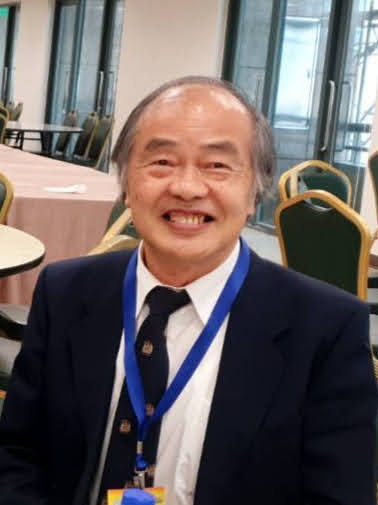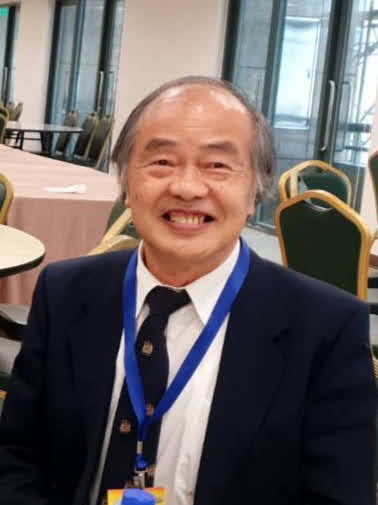AUCTORES
Globalize your Research
Review Article | DOI: https://doi.org/10.31579/2766-2314/150
*Corresponding Author: Loutfy H. Madkour, Chemistry Department, Faculty of Science, Tanta University, 31527, Tanta, Egypt.
Citation: Loutfy H. Madkour, (2025), In vitro and In vivo Bioimaging and Photoelectronic Applications of Graphitic Carbon Nitride (g‑C3N4) Composite in Drug Delivery Systems for Cancer Cells Treatment, J, Biotechnology and Bioprocessing, 6(1); DOI:10.31579/2766-2314/150
Copyright: © 2025, Loutfy H. Madkour. This is an open access article distributed under the Creative Commons Attribution License, which permits unrestricted use, distribution, and reproduction in any medium, provided the original work is properly cited.
Received: 08 January 2025 | Accepted: 21 January 2025 | Published: 04 February 2025
Keywords: g-C3N4 modifications; biosensing; bioimaging; drug delivery; cancer therapy; biomedical and healthcare applications
Recently, nanomaterials have been widely applied as biosensors with distinctive features. Graphite phase carbon nitride (g-C3N4) is a two-dimensional (2D) carbon-based nanostructure that has received attention in biosensing. Biocompatibility, biodegradability, semiconductivity, high photoluminescence yield, low-cost synthesis, easy production process, antimicrobial activity, and high stability are prominent properties that have rendered g-C3N4 a promising candidate to be used in electrochemical, optical, and other kinds of biosensors. These applications encompass a meticulous exploration of detecting biomolecules, drug molecules. Graphitic carbon nitride (g-C3N4) has garnered much attention as a promising 2D material in the realm of electrochemical sensors. It contains a polymeric matrix that can serve as an economical and non-toxic electrode material for the detection of a diverse range of analytes. However, its performance is impeded by a relatively limited active surface area and inherent instability. Although electrochemistry involving metal-doped g-C3N4 nanomaterials is rapidly progressing, it remains relatively unexplored. The metal doping of g-C3N4 augments the electrochemically active surface area of the resulting electrode, which has the potential to significantly enhance electrode kinetics and bolster catalytic activity. Consequentially, the main objective of this chapter is to provide insight into the intricacies of synthesizing and characterizing metal-doped g-C3N4. Furthermore, we comprehensively delve into the fundamental attributes of electrochemical sensors based on metal-doped g-C3N4, with a specific focus on healthcare and environmental applications. Graphitic carbon nitride (g-C3N4) belongs to an older age class of 2-D semiconducting materials that are affordable, metal-free, indispensable towards sensing applications due to identifiable changes in their conductivity after analyte exposure especially when they are in the nano-regime. This review presents the g-C3N4 unique features, synthesis methods, and g-C3N4-based nanomaterials. In addition, recent relevant studies on using g-C3N4 in biosensors in regard to improving treatment pathways are reviewed.
Graphitic carbon nitride (g-C3N4, composed of the sp2 hybridization with highly delocalized π-conjugated electronic structures) is typical metal-free polymer semiconductor, which has currently been attracted wide attention in energy conversion/storage and environmental remediation due to its various advantages such as high physicochemical stability, unique electronic band structure of visible light responsive sensitivity, and “earth-abundant” nature [1]. More than 25,400 scientific papers concerning carbon nitride or g-C3N4 were searched in Web of Science (1/1/2018–23/4/2023).The g-C3N4 is comprised of only carbon and nitrogen elements, which are very abundant on the Earth. Importantly, the g-C3N4 materials can be easily fabricated by thermal polymerization of abundant nitrogen-rich precursors such as melamine [2,3], dicyandiamide [4], cyanamide [5], urea [4,6], thiourea [7,8], ammonium thiocyanate [9], etc. Because the band gap of g-C3N4 is 2.7 eV, it can absorb visible light shorter than 450 nm effectively, implying broad prospects in solar energy conversion applications. Due to the aromatic C-N heterocycles, g-C3N4 is thermally stable up to 600 °C in air. Moreover, g-C3N4 is insoluble in acids, bases or organic solvents, exhibiting good chemical stability.The well-known 2D material, graphitic carbon nitride (g-C3N4) with stable allotrope, has shown its wider applications in catalysis, photoelectrochemical sensing [10], energy related photoelectronic devices, electrochemical sensor [11], biomedical imaging, biosensor [12] and spectroscopic detections [13]. In brief, graphitic carbon nitride (g-C3N4) emphasized the analog skeleton to graphite, found to be promising and fascinating material containing its sturdy C–N covalent bonds instead of C–C in graphite and the layers that are linked by van der Waals forces [10]. The incorporation of heteroatoms such as nitrogen atom into carbon-based materials can enhance the properties of existing material whereby, the nitrogen atom act as the strong electron donor sites for catalytic conductivity due to the chemical nature of the nitrogen atom [14]. The tri-s-triazine present in the ring structure as well as the high degree of condensation provide ascend to a medium bandgap polymer and indirect semiconductor that was utilized in the field of energy storage [15], electrocatalysis [16], sorbents, heavy metals detection, pesticides detection, photocatalysis, photoelectrocatalysis [10,16] and sensing applications [10,17]. The g-C3N4 nanostructures play a vital role in the development of g-C3N4 based materials for electrochemical sensing [10]. Apart from catalytic activity and conductivity, the important driving force of the electrode materials will offer the facile interactions through chemical and biological analytes and the control of the functional moieties to extremely selective sensing and limit of detection [10]. Scan of literature from the ‘Web of Science’ showed the maximum number of articles on g-C3N4 are found to be increased year by year in the field of sensors and plausible modifications towards hybrids or composites with other than carbon-based nanomaterials such as metals, semiconductors, graphene, etc. and also real time samples also were detected [17]. Several reviews explored the synthesis, characterization of g-C3N4 [10]. Some of the reviews establish the g-C3N4 applications in the field of catalyst, imaging, and LEDs and beyond photocatalyst, few reviews are reported with structural, morphological, sensing properties of g-C3N4 [10,18]. Though several domains have employed g-C3N4 material, they play an indispensable role in electrochemical detection. Fortunately, a variety of articles on g-C3N4 based electrochemical sensors and biosensors have risen [10], but, no specific reviews were highlighted to show the importance of sensor point of view with real-time monitoring. A systematic description of the g-C3N4 based nanomaterials used for an electrochemical sensor for environmental application and biosensor for healthcare applications has been shown in Scheme 1

Scheme 1. Graphitic carbon nitride based electrochemical and biosensors for environmental and healthcare applications [10].
To obtain g-C3N4 structures with well-defined morphology applicable for fabricating a sensor, pyrolysis technique is generally used with different nitrogen-rich precursors. such as melamine, urea, thiourea, dicyandiamide, cyanamide, and guanidine hydrochloride were developed and applied it for electrochemical catalysis with a remarkable detection limit for various analytes.
Thus, recent research has highlighted the potential of g-C3N4 composites in effectively removing various pollutants from wastewater, such as dyes, oil spills, heavy metal ions, pesticides, microplastics, phenols, and pharmaceuticals [19-23]. Moreover, there is increasing research interest in utilizing g-C3N4-composites for hydrogen generation [24]. The number of publications focusing on pollutant removal and H2-production using g-C3N4 nanocomposites has shown a notable increase over the last few years, as seen in Fig. 1. Initially, there were only a few publications per year, indicating limited attention to the topic. However, since 2017, there has been a rapid upward trend in both citations and publications, signifying a growing interest in the field, where documents on photocatalysis were almost five times higher than those on H2-production. Most of these publications consist of journal articles (93%), with a smaller fraction being reviews (4.9%), and conference articles (1.1%), as shown in Fig. 1. This indicates a scarcity of dedicated and updated review papers, which are essential for providing interested researchers and the scientific community with a comprehensive and up-to-date evaluation of g-C3N4-composites' application as photocatalysts.

Figure 1: Number of publications in Scopus database reporting g-C3N4-based composites for photocatalytic and H2-production applications: keywords “(g-C3N4) and ((photocataly*) or (hydrogen production))”.
Recently, g-C3N4 has drawn increasing attention in constructing biosensors owing to its appealing properties such as responsive to visible light, facile synthesis from inexpensive raw materials with modulable electronic structures, remarkable thermal and physicochemical stability, abundant functional groups on the surface, and excellent photoelectrochemical features.
One of the emerged semiconductors photocatalysts which have received much global attention is the two-dimensional Graphitic Carbon Nitride (g-C3N4) nanomaterial. It is an earth-abundant metal-free semiconductor with easily tunable optical, electronic, and good visible-light harvesting properties. With a reasonable bandgap energy of 2.7 eV (460 nm), g-C3N4 is physically and chemically robust. It also has the appropriate Conduction Band (CB) and Valence Band (VB) edge positions for both reduction and oxidation reactions [25-27]. Based on these unique properties, g-C3N4 has been applied in various fields such as photocatalysis (removal of environmental pollutants, energy conversion systems, energy generation, etc.), photovoltaics, sensors, and electrochemical devices among others [28-30].
Graphitic carbon nitride (g-C3N4) has a chemical composition of only carbon and nitrogen, having unique optoelectronic features, electrochemical performance, appropriate band gap, chemical inertness, superior mechanical and thermal stability, two-dimensional structure, outstanding chemical
stability and configurable electronic structure, and has received significant research attention. These properties resulted in increasing research exploration for diverse applications and the foundation for the development of various products. A scientometric analysis of g-C3N4-based materials reveals a current shift in applications of the materials from energy conversion systems, hydrogen production, photoelectrochemical, and other disciplines to diverse disciplines. In recent years, g-C3N4-based materials have been used in a variety of new fields such as medicine, food safety, mathematics, and computer science. As a result, this chapter was conducted in an attempt to summarize the new emerging disciplines of applications of g-C3N4-based materials as a reference base and to provide information for further exploration and expansion of research areas. It was predicted that g-C3N4-based materials could be used in sensors and actuators, automotive systems, biomimicry technology, and other multidisciplinary fields.
The early detection of the biomarkers of the diseases plays a significant role in their treatment and control. It is essential to detect biomarkers associated with a disease early and with the high precision for diagnosis, treatment, and prognosis of fatal diseases, such as cancer, which causes a high mortality rate yearly, and neurodegenerative disorders [31-34]. There are some current conventional diagnostic methods, such as blood tests, imaging, and biopsies, which can be expensive and time-consuming with low sensitivity. Moreover, they require trained personnel, limiting their availability to low-income patients [33].
Today, biosensors are used for detection approaches, such as the high-resolution imaging, fast detection, and monitoring of diseases. Biosensors consist of three main components: recognition, signal transducer, and processor, designed to determine specific biomolecules [35]. These biomolecules can be macromolecules, such as nucleic acid and proteins, or small molecules, such as glucose. Various cancer biomarkers, such as BRCA1, BRCA2, CA 15-3, and CA 125 for breast cancer and PSA for prostate cancer, can be detected as well [36]. In this sense, biosensors based on nanomaterials have accurate detection, efficient monitoring, and fast but reliable imaging [37,38]. The physicochemical properties of nanomaterials, such as photoemission, high specific surface leading to extra bioreceptor immobilization, as well as electrical and heat conductivities, make them perfect candidates for biosensor construction [39-43]. Graphene/graphene oxide, carbon quantum dots, gold nanoparticles, carbon nanotubes, porous carbon, and fullerene are nanostructures that have been investigated as the biosensing platforms studied over the years [44-53]. Carbon nanostructure-based sensors are utilized due to their potential to quench fluorescently-labeled probes [37-41,54]. Thus, developing a user-friendly and highly sensitive biosensor is essential. Graphitic carbon nitride (g-C3N4) nanosheet is another widely used carbon nanostructure to design biosensors [55-60]. g-C3N4 nanosheets have high fluorescence quantum yield, superior chemical and thermal stability, are easy to synthesize with low toxicity, and have a low price and high biocompatibility together with unique photoelectrochemical and electroluminescent characteristics [61,62]. Furthermore, the optical properties and conductivity of g-C3N4 have made it applicable in optical and electrochemical biosensing approaches. For instance, sulfur-doped graphitic carbon nanosheets (s-g-C3N4) as a dual (electrochemical and fluorescence) biosensing platform were used for the detection of cancer biomarkers even at very low concentrations (CA15-3) [63]. This chapter summarizes the properties and synthesis methods of graphitic carbon nitride nanosheets, which make them highly suitable candidates for the next generation of biosensors for healthcare and biomedical applications.
2. Historical progress of g‑C3N4
Table 1 depicts the historical progress of g-C3N4 and was adapted from a study conducted by Ajiboye et al. (2020) [64]. The discovery of “melon” by Liebig and Berzelius in the 1830s sparked interest in g-C3N4 research. The melon contains a tri-s-triazines monomer that is interconnected by a tertiary amine. The historical evolutionary trend in Table 1 shows that several authors have studied g-C3N4 with its introduction as a heterogeneous catalyst in the year 2006. Specifically, its application as a photocatalyst was reported by Wang et al. (2009) for water splitting. Following this breakthrough, several studies involving g-C3N4 were conducted and applied in a variety of disciplines and fields.
| Year | Works on g-C3N4 |
| 1834 | Berzelius made synthetic polymer which was a derivative of carbon nitride. It was named as ‘‘melon’’ in 1834 by Leibig |
| 1835 | Sulfur and potassium ferricyanide was heated together in a crucible to make potassium hydromelanote by Gmelin |
| 1922 | The term ‘‘carbonic nitride’’ was introduced and it was found to be formed as the last product of several ammonocarbonic acids using melon as the starting material by Franklin |
| 1937 | Tri-s-triazine was suggested as repeat monomer unit of graphitic carbon nitride by Sturdivant and Pauling |
| 1940 | Resemblance between graphite and melon was pointed out by Lucas and Redemann. They were both planar and very large |
| 1982 | Derivative of cyameluric was obtained as the pioneer crystal structure by Leonard et al. |
| 1990 | Sp3-bonded β-C3N4 was theoretically predicted to have hardness and bulk modulus that is either equal or greater than that of diamond |
| 1996 | Although by calculation methods, graphitic carbon nitride was shown to have five structural types by Hemley and Teter |
| 2001 | Species having high crystallinity which was believed to be melon possessing high molecular weight was reported by Komatsu |
| 2003 | Melam and melem derivatives were isolated and identified as the crystalline structure of heptazine by Schnick et al. |
| 2006 | g-C3N4 was discovered to be a heterogeneous photocatalyst without containing metals |
| 2007 | Milan et al., converted dicyandiamide to imide phase carbon nitride |
| 2009 | Semiconductor without metal-based hydrogen generation by Wang using g-C3N4 |
Table 1: Historical summary of progress on g-C3N4. Source: Ajiboye et al. [64]
3. Allotropes of g‑C3N4
The primary allotropes of C3N4 include beta-g-C3N4 (β-g-C3N4) and triazine-based g-C3N4 (T-g-C3N4), graphitic-C3N4, cubic-C3N4 and pseudo-cubic-C3N4. The diamond-like α-g-C3N4 is the most stable allotrope of g-C3N4, where four nitrogen atoms in a tetrahedral configuration are bonded to each carbon atom. Its light absorption capacity is limited to the ultraviolet region due to its wide band gap of about 4.8 eV. Further, it has little electrical conductivity and low photocatalytic efficiency. The graphite-like structure i.e., β-g-C3N4 is a metastable allotrope of g-C3N4, where carbon and nitrogen atoms are arranged in hexagonal rings forming layered sheets. It has a small band gap of about 2.7 eV, which ranges its light absorption capacity to the visible light region. Its electrical conductivity and photocatalytic activity are also higher than α-g-C3N4. g-C3N4 is a general term for the graphitic carbon nitride-based materials that have a graphite-like structure but with altered degrees of porosity, crystallinity, and imperfection [65].
4. Structural Properties of g‑C3N4
g-C3N4 is a polymeric nanosheet with a graphene-like structure consisting of sp2 bonded carbon and nitrogen atoms with abundant amino groups on its surface and suitable bandgap energy of 2.7 eV [66]. Thanks to the g-C3N4 electronic band structure with sp2 hybridization, it is considered a photon-harvesting semiconductor material that plays a critical role in detecting biomolecules by photoelectrochemical (PEC) biosensors [67]. Due to the presence of melamine in the π-conjugated nanosheets, g-C3N4 is fluorescent with high photoluminescence quantum yield with high and minor absorption at 365 nm and visible light region, respectively [68,69], which can be quenched by materials, such as metal ions, nitrobenzene derivate, or biomolecules, such as heparin and sialic acid, which allow its use as a fluorescent probe biosensor[70] with high photostability and no obvious photobleaching under UV light excitation for 10 h [71]. Furthermore, the g-C3N4 ability to convert light and electricity makes it a suitable option for electrochemiluminescence-based and photoelectrochemistry-based biosensing [60]. Various precursors have been proposed for g-C3N4 synthesis through thermal condensation. These compounds are rich in nitrogen and contain a tri-s-triazine ring structure, such as dicyandiamide, urea, cyanamide, or thiourea [72]. For instance, if cyanamide is selected as the precursor, thermal heating results in dicyanamide, melamine, melem, and g-C3N, respectively. The molecular structures of the g-C3N4 precursors and the corresponding temperatures for their thermal condensation are depicted in Figure 2.

Figure 2: (A) Various g-C3N4 precursors and the corresponding temperatures for their thermal condensation into g-C3N4-, [73]. (B) g-C3N4 structure, [74].
In addition, g-C3N4 has been reported to display antimicrobial activity. A number of parameters, including the g-C3N4 band gap, intermediate defect states, dispersed surface area, absorbance in suspension, and charge separation influence its photocatalytic bacterial inactivation [60]. Thus, the modification of this properties influences the production of reactive oxygen species, hence the antibacterial activity. The bactericidal rates of more than 99% have been successfully achieved for eight kinds of foodborne pathogenic bacteria with 8 h incubation in the dark. Cell rupture caused by direct mechanical contact between g-C3N4 and cell membranes has been observed. Molecular dynamics simulations further indicated that the presence of large defects in g-C3N4 enhanced the electrostatic attraction between inherent pores and lipid heads, resulting in enhanced antibacterial activity. The thermal and chemical stability of biosensors is crucial for long shelf lives. g-C3N4 nanosheets show high thermal stability in the air (up to 600 °C) thanks to the graphitic graphene-like structure with sp2 bonds between carbon and nitrogen, providing high chemical stability [75]. g-C3N4 has low cytotoxicity and good biocompatibility due to its metal-free structure. Moreover, it has a low production cost, a simple synthesis process, a large specific surface area, easy functionalization, and increased penetration coefficient, allowing the efficient immobilization of molecules in the matrix for biosensing [76]. As g-C3N4 materials are increasingly used in biomedicine, improving their biocompatibility and biodegradability properties is a necessity. Therefore, modifications are applied to enhance the biocompatibility, biodegradability, and further development of g-C3N4 materials. For instance, Kang et al. showed that successfully inserting abundant disulfide bonds into g-C3N4 endowed more biodegradability and biocompatibility, boosting its application in biomedical fields [77]. In another study that was recently conducted for glucose detection in diabetic patients, the addition of metal co-catalysts (Fe(III), Cu(II)) to the structure via adsorption noticeably enhanced the sensitivity compared to the pristine g-C3N4 [78]. Thanks to its easy functionalization, g-C3N4 can be adapted to various targets with high sensitivity. For instance, a platform based on proton-functionalized ultrathin g-C3N4 nanosheets with a positive charge has been developed for heparin (as a biomolecule with a high negative charge) detection in human serum [79]. Graphitic carbon nitride (g-C3N4) exhibits a unique two-dimensional structure composed of carbon and nitrogen atoms, which imparts distinctive structural properties crucial for its photocatalytic performance [80,81]. Understanding these properties is essential for tailoring g-C3N4 materials to specific applications and optimizing their efficiency. The key structural attributes are provided in Figure. 3.

Figure 3: Structural properties of pristine g-C3N4.
4.1. Layered structure
At its core, g-C3N4 consists of stacked layers of carbon and nitrogen atoms arranged in a planar, hexagonal lattice. This layered structure resembles that of graphite, giving rise to its name, “graphitic”. Each layer is composed of tri-s-triazine (C3N3) units, and the layers are held together by weak van der Waals forces. This layered configuration provides a large surface area for potential reactant adsorption and photocatalytic reactions, making g-C3N4 an attractive material for various applications [82]
4.2. sp2-hybridization
The carbon atoms within the g-C3N4 lattice adopt sp2-hybridization, resulting in trigonal planar geometry. This sp2-hybridized carbon configuration is responsible for the formation of delocalized π-bonds, contributing to the material's excellent electrical conductivity and optical properties. This electron-rich network facilitates charge carrier mobility and separation, which are essential for efficient photocatalysis [83].
4.3. Bandgap
The electronic band structure of g-C3N4 plays a pivotal role in its photocatalytic activity. It exhibits a moderate bandgap typically around 2.7 to 2.8 eV, making it responsive to visible light. Photons with energy equal to or greater than the bandgap can excite electrons from the valence band to the conduction band, initiating the photocatalytic process. The bandgap value allows g-C3N4 to harness a substantial portion of the solar spectrum, rendering it effective for solar-driven applications. [84].
4.4. Surface area and porosity
The layer-by-layer structure of g-C3N4 results in a high surface area, providing ample sites for reactant adsorption and subsequent photocatalytic reactions. The interlayer spacing between g-C3N4 layers can be tuned to create mesopores and micropores, further enhancing its surface area and porosity. These structural features facilitate efficient mass transport and reactant accessibility, promoting photocatalytic efficiency [85].
4.5. Surface chemistry
The surface of g-C3N4 can be modified through functionalization, which introduces various functional groups such as amino, hydroxyl, and carboxyl groups. These modifications can influence the material's surface charge,
hydrophilicity, and chemical reactivity, thus tailoring its suitability for specific photocatalytic applications. Surface functionalization also enables the attachment of co-catalysts, enhancing charge separation and overall photocatalytic performance [84]. Moving to structural properties, g-C3N4's layered structure, sp2-hybridization, moderate bandgap, high surface area, and porosity are key features. The layered structure provides a large surface area for reactions, while sp2-hybridization contributes to electrical conductivity. The moderate bandgap (2.7–2.8 eV) enables responsiveness to visible light, crucial for solar-driven applications. High surface area and porosity, achieved through the layer-by-layer structure and tuned interlayer spacing, facilitate efficient mass transport and reactant accessibility. Surface chemistry, modified through functionalization, further tailors’ properties for specific applications [86]. Understanding these structural properties allows researchers to design and engineer g-C3N4 materials with optimized characteristics for diverse photocatalytic applications. By tailoring the layer spacing, bandgap, and surface chemistry, g-C3N4 can be fine-tuned to address specific environmental and energy challenges, contributing to a sustainable and cleaner future.
5. Synthesis Methods
The synthesis of graphitic carbon nitride (g-C3N4) has undergone significant development over the years, offering researchers a versatile toolkit to tailor its properties for specific photocatalytic applications. The following sections explore several key synthesis methods, each with its own advantages and limitations.
5.1. Thermal polymerization
One of the most widely employed methods for g-C3N4 synthesis is thermal polymerization of low-cost precursors, such as melamine, urea, cyanamide, dicyanamide, thiourea, cyanuric acid etc. This process typically involves the heating of these precursors at moderate temperatures (around 500–600 °C) under inert gas atmospheres (Fig. 4). The thermal polymerization route generates a layered g-C3N4 structure with a high surface area, making it suitable for various photocatalytic applications. The method's simplicity and cost-effectiveness have contributed to its popularity [87-89].

Figure4 Synthesis of g-C3N4 via thermal polymerization method.
5.2. Chemical vapor deposition (CVD)
CVD represents an alternative approach to g-C3N4 synthesis, offering precise control over the material's thickness and morphology. In CVD, volatile precursors, such as cyanamide, are introduced into a high-temperature reactor, where they decompose and deposit as g-C3N4 on substrates (shown in Figure. 5). This method allows for the growth of thin films and nanostructures, enabling applications in photovoltaics and optoelectronics. However, CVD may require more specialized equipment and is often associated with higher production costs [90-93].

Figure 5: Synthesis of g-C3N4 via CVD method.
5.3. Solvothermal and hydrothermal methods
Solvothermal and hydrothermal routes involve the reaction of precursors in high-pressure, high-temperature aqueous or organic solvents (Fig. 6). These methods offer control over the morphology and structure of g-C3N4 by adjusting reaction conditions. Solvent selection plays a crucial role in influencing the final product's properties. Hydrothermal synthesis is particularly effective in producing hierarchical g-C3N4 structures with enhanced photocatalytic activity. These methods are advantageous for tailoring g-C3N4 for specific applications and have gained prominence in recent years [94-98].

Figure 6: Hydrothermal synthesis of g-C3N4 particles.
5.4. Template-assisted synthesis
Template-assisted synthesis involves the use of templates, such as mesoporous silica or carbonaceous materials, to guide the formation of g-C3N4 with specific structures (Figure. 7). By using templates with desired pore sizes and shapes, researchers can control the surface area and porosity
of g-C3N4, which are critical factors affecting its photocatalytic performance. This approach enables the creation of g-C3N4 materials with finely tuned properties for applications like pollutant removal and solar energy conversion [99-103].

Figure 7: Template-assisted synthesis of g-C3N4 particles.
5.5. Doping and co-doping strategies
To further enhance the photocatalytic activity of g-C3N4, doping and co-doping with other elements, such as sulfur, boron, and metals, have been explored (as shown in Fig. 8). Doping introduces impurities into the g-C3N4 lattice, modifying its electronic structure and creating additional active sites for photocatalytic reactions. Co-doping involves the simultaneous incorporation of two or more elements to achieve synergistic effects. These strategies play a pivotal role in improving g-C3N4's efficiency and selectivity in various photocatalytic processes [104-108].

Figure 8: Metal/metal oxide doped g-C3N4 synthesis via doping strategies.
The synthesis of graphitic carbon nitride (g-C3N4) has advanced significantly, providing a diverse set of methods with distinct advantages and limitations. Thermal polymerization, involving low-cost precursors like melamine, offers simplicity and cost-effectiveness, resulting in a layered g-C3N4 structure suitable for various applications. Chemical vapor deposition (CVD) allows precise control over thickness and morphology but may entail higher production costs and specialized equipment. Solvothermal and hydrothermal methods, utilizing high-pressure and high-temperature conditions, provide morphology control and have gained popularity for tailoring g-C3N4 properties. Template-assisted synthesis uses templates to guide specific structures, influencing surface area and porosity critical for photocatalytic performance. Doping and co-doping strategies enhance photocatalytic activity by modifying the electronic structure.
Comparing these methods reveals trade-offs in terms of cost, complexity, and yield. Thermal polymerization is cost-effective and straightforward but might lack precision. CVD offers control but at higher costs. Solvothermal and hydrothermal methods provide control over morphology but involve specialized conditions. Template-assisted synthesis allows tailored structures but might be more intricate. Doping strategies enhance performance but add complexity. The choice depends on desired properties and applications, influencing cost-effectiveness and efficiency [86].
In summary, the choice of synthesis methods for g-C3N4 is influenced by the desired properties and intended applications. Researchers and engineers can select from these diverse synthesis techniques to tailor g-C3N4 materials that meet the specific demands of sustainable environmental applications, from water purification to renewable energy production.
6. Synthesis Methods of g‑C3N4-Based Materials
The cyanamide is infiltrated and polymerized in the narrow void of SNSs to form porous g-C3N4, and then the SNSs is removed by HF treatment, as shown in Figure 9a. Therefore, the resulting g-C3N4 has an anti-opal structure, and the size of the spherical hole indicates the size of the SNSs used, as shown in the SEM images of Figure 9b–e. In this study, the pore size of g-C3N4 was between 50 and 80 nm. In spite of the silica hard template, Chen et al. reported the synthesis of porous g-C3N4 by using multi-walled carbon nanotube (CNT) as a novel hard template [109. Unlike other hard templates, CNT can be easily removed and recovered by ultrasonic methods, resulting in a relatively simple preparation of porous g-C3N4.

Figure 9 (a) Synthesis procedure of ordered porous g-C3N4. Field emission SEM (FESEM) images of porous g-C3N4 prepared using silica spheres with various diameters: (b) 20, (c) 30, (d) 50, and (e) 80 nm [110].
The synthesis of g-C3N4 is normally through the polymerization using various synthesis techniques such as chemical vapor deposition (CVD), solid-state reaction, physical vapor deposition (PVD), solvothermal method and thermal nitridation [25,111]. Unfortunately, the product obtained is bulk g-C3N4 which normally exhibits poor optoelectronic properties and hence cannot be utilized and applied in many fields in that form. Thus, to overcome this challenge various nanostructured g-C3N4 such as ultrathin nanosheets, hollows, nanorods, nano leaves, etc. have been prepared with improved optical and electronic properties [112]. Furthermore, nanostructured and nanocomposites of g-C3N4 have enhanced properties such as low electron–hole recombination rate, large surface area, and so on, making them suitable for applications in a variety of fields. Over 400 reviews on g-C3N4 have been conducted, according to Vinoth et al. (2021), with applications including energy conversion systems, hydrogen production, and photoelectrochemical studies, among others.
The structural limitations, including low surface area and insufficient porosity, reduce catalytic activity while ensuring the stability of Z-scheme interfaces and preventing back electron transfer remains complex. Moreover, scaling up production and achieving cost-effective synthesis are ongoing hurdles. Addressing these challenges requires innovations in bandgap engineering, composite formation, and morphology control, along with the development of green and scalable synthesis methods.
6.1. Synthesis of g-C3N4 Nanosheets
The classification of the synthesis methods based on the synthesis procedure can be divided into bottom-up and top-down categories. The “bottom-up” approach generally applies small-sized particles to assemble complex structures. However, the “top-down” procedure is based on splitting large-sized and thick bulks into small particles and thin nanosheets [113,114]. The bottom-up procedure includes ionic liquid, supramolecular pre-assembly, and hydrothermal methods [114]. In the bottom-up approach, g-C3N4 sheets are synthesized on a large scale via thermal polymerization (pyrolysis) or the carbonization of small organic compounds (that contain hydroxyl, carboxyl, carbonyl, and primary amine functional groups) [115], such as melamine, cyanimide, Dicyanamide, or urea [116]. Dante et al. obtained g-C3N4 from the pyrolysis of melamine cyanurate at 650 °C for 50 min (in the crucible with atmosphere condition), which was used for glucose sensing [78]. On the other hand, chemical exfoliation and ultrasonic exfoliation methods have been utilized for the top-down approach. Chemical exfoliation is more common for large-scale production due to its high efficiency and the easier tuning of the g-C3N4 structure [117]. For example, Hatamie et al. used g-C3N4 as a label-free fluoro-sensor to analyze the amount of metronidazole in biological fluids and drug samples. g-C3N4 ultrathin nanosheets were synthesized in bulk via the thermal polymerization method from melamine, possessing a highly π-conjugated structure at 600 °C. The exfoliation procedure was performed through ultrasonication in water media [118].
6.2. Synthesis of g-C3N4-Based Composites
g-C3N4 properties can be enhanced through its fabrication with other materials into composites. In the modification techniques, metal loading is critical for increasing the potential application of g-C3N4 biosensors due to outstanding electrochemical qualities. Metal/g-C3N4 composites are produced with solvothermal treatment, photo-deposition, precipitation, and thermal polymerization methods [119]. Generally, there are numerous ways to prepare g-C3N4-based nanocomposites. The simple pyrolysis method, solution (sonication) mixing, the hydrothermal method, the simple calcination method, the hydrolysis method, sol-gel, and microwave irradiation are some synthesis methods that have been applied in the formation of nanocomposites based on g-C3N4- and have been utilized for different applications [66]. The pyrolysis method is a common way to produce g-C3N4-based composites in diagnosis applications where the mixture of the precursor of g-C3N4 and the other components is calcinated in a crucible for a while with a specific heating rate and initial temperature to prepare the nanocomposite. Then, the product is cooled at 25 °C. For example, a sensitive electrochemical sensor for dopamine detection was fabricated by firstly preparing calcium stannate (CaSnO3) nanoparticles from CaCl2 and SnCl2.2H2O via the hydrothermal method, then CaSnO3-gC3N4 nanohybrid was produced through the pyrolysis of melamine, (NH4)2SO4, and CaSnO3 mixture at 550 °C in a crucible [120]. In another study for glucose detection, Cu(II)–Fe(III)-g-C3N4 was prepared through the sonication method (2 h sonication of a suspension of 416 mg of g-C3N4 in a 20 mL aqueous solution containing Cu(II) and Fe(III) ions), which led to the adsorption of ions on the g-C3N4 structure [78]. A highly selective glucose-sensing (in human blood) biosensor based on ultrathin g-C3N4 nanosheets doped with niobium (Nb) metal was synthesized by the pyrolysis method from urea [121]. A biosensor for 4-nitrophenol detection was developed by Vinoth et al. 4-nitrophenol is a very poisonous chemical compound released into the water during the production of some drugs, dyes, and leather, posing human health at high risk. So, for 4-nitrophenol monitoring, the biosensor based on BaSnO3-g-C3N4 nanostructure was synthesized by sonication method from prepared BaSnO3 and g-C3N4 [122].
7. Synthesis of g-C3N4 -Based Biosensors
7.1. g-C3N4-Based Surface Plasmon Resonance (SPR) Biosensors
Surface plasmon resonance (SPR) sensing is a powerful probe of the interplays between protein–ligand, protein–DNA, protein–protein, and protein–membrane binding [123]. SPR biosensors are a very effective tool for measuring many biomarkers [124]. The main advantages of these biosensors are their fast response and ability to detect various analytes concurrently [125]. Moreover, among various new techniques available, SPR biosensors are the best optical biosensors for label-free, fast, and in situ diagnosis of molecules [61]. SPR is a physical optics phenomenon that can detect biomarkers because of the high sensitivity of surface plasmons to the dielectric medium [126]. In these biosensors, receptors are immobilized on the metal surface, interacting with the analytes and leading to dielectric alteration. This phenomenon affects the resonance condition of surface plasmons with specific surface plasmon waves (SPWs), allowing the transmission of photon’s energy to the surface plasmons at the resonance angle resulting in the decrease of the light reflectance and thus the SPR curve [127]. Based on the characteristic of light, the SPR biosensors can be categorized into angular, wavelength, or intensity-modulated systems [128-130]. The Kretschmann configuration is the most recent version of SPR based on attenuated total reflection [77]. At an angle, part of light energy is transmitted to the surface plasmon, and the reflectance can be shown in the angular scanning. The presence of adsorbed molecules on the biosensor surface varies the refractive index, and the SPR angle is changed accordingly [131].
Two-dimensional (2D) materials with large surface areas, such as g-C3N4, can act as the sensitive layers for SPR [61]. Duan et al. designed a surface plasmon resonance (SPR) biosensor based on a 2D nanocomposite of g-C3N4 nanosheets and molybdenum disulfide quantum dots (MoS2QDs), adorned with chitosan-stabilized Au nanoparticles (CS-AuNPs) to detect prostate specific antigen (PSA) selectively. In this work, the MoS2QDs easily aggregated and reduced the sensitivity, but as a support for MoS2QDs, the g-C3N4 nanosheets improved the biosensing performance for PSA detection. Additionally, the MoS2QDs@ g-C3N4@ CS-AuNPs-based SPR apt sensor showed a very low limit of detection (LOD), 0.77 ng·mL−1, with good linearity range at PSA concentrations in the range of 1.0–250 ng·mL−1 [61].
7.2. g-C3N4-Based Electrochemical Biosensors
Electrochemical biosensors have been recognized as powerful diagnostic tests over the past years thanks to their unique advantages, such as simplicity, high sensitivity, and accuracy [132]. Three vital components are necessary to develop electrochemical biosensors: (I) a bioreceptor to link with analyte, (II) an electrode, and (III) a read-out system [133]. An electrochemical sensor requires a working reference and an auxiliary electrode; the working electrode in the electrochemical biosensor acts as a transducer in the reaction between the bioreceptor and the analyte. It generates a biological signal which changes into an electronic signal and is processed with high sensitivity [134]. On the other hand, Ag/AgCl-based reference electrode is kept at the site of the reaction to maintain a particular potential. The auxiliary electrode links the electrolytic solution and must be conductive; thus, gold or platinum are suitable candidates [135]. Some electrochemical methods for marker detection include voltammetric techniques (cyclic, square wave, or stripping), impedimetric, and amperometry. Of these techniques, cyclic voltammetry (CV) is preferred [133].
In an electrochemical biosensor, an electrode is the main component for immobilizing electron motion and biomolecules [136]. Nanomaterials have piqued attention due to their unique electronic characteristics [137]. The carbon allotropes can be applied as electrodes due to their effective electron transfer rate and high active surface area. Additionally, carbon nanostructured materials are significant in research due to their unparalleled properties, such as chemical stability and good conductivity [138]. g-C3N4 is a polymeric semiconductor with a specific structure and high stability, making it a good nanocomposite for electrochemical biosensors [139]. g-C3N4 is known as the most thermal stable allotrope of carbon nitrides [140], which can be used in the diagnosis system based on its catalytic ability [141]. Due to the low electron conductivity of g-C3N4, it has been used with other materials to enhance its surface conductivity. The g-C3N4 derivatives can electrically connect to the redox center of biomolecules on the surface of the electrode. The electronic integration of the g-C3N4 with various carbon types notably increases the surface area and conductivity [141]. The chemical exfoliation of bulk g-C3N4 has been used to develop g-C3N4 nanosheets for the detection of neurotransmitters, such as dopamine (DA). Kathiresan et al. developed a glassy carbon electrode (GCE) doped with bulk g-C3N4. The electrochemical activation of bulk g-C3N4 was performed with a potential of 1.75 V in neutral pH conditions (pH 7.0). In the electrode oxidation reaction, the two-electron process is followed by the transfer of two protons, resulting in 5-HTquinoneimine. Figure 10 illustrates the redox reaction. Oxidation leads to the transfer of protons to form 5-HTquinoneimine and the reduction occurs in the quinone group on 5-HT quinonimine [142].

Figure 10: Activation of g-C3N4 on glassy carbon electrode and the redox reaction on the developed electrochemical biosensor for serotonin (5-HT)-. [142].
7.3. g-C3N4-Based Photoelectrochemical (PEC) Biosensors
The photoelectrochemical (PEC) detection method is a hopeful technique for biological assays [143], which is also a low-cost approach to transforming chemical energy into electricity under a flash of light [144], and PEC biosensors have become prominent due to their capability of biomolecules diagnosis. This method has had much consideration because of its high sensitivity, simplicity, and fast response [145]. In the PEC diagnosis system, light is used as an excitation source [146], allowing for a high sensitivity with low background signals [144]. The PEC cell includes three main components: (a) a light-harvesting semiconductor, (b) a metal electrocatalyst, and (c) adequate electrolytes among the working electrode and auxiliary electrode to generate PEC signals using redox reaction. Upon illumination, the redox reactions lead to a signal between the working and the auxiliary electrodes [147]. PEC biosensors use wide bandgap semiconductors as photoactive materials [119], changing optical energy to electrical and chemical energy [148]. g-C3N4 is a responsive photocatalyst with a bandgap (2.7 eV) [149]. Additionally, one of the promising approaches is a photocatalytic reaction which can absorb visible light [138]. g-C3N4, as an inorganic polymeric semiconductor, possesses a graphite-like layer structure [150]. So, PEC biosensors show advantages over electrochemical and optical biosensors with high sensitivity and low cost. Hence research in the PEC biosensor for analyte detection has increased. Biomarkers detected using photoelectrochemical biosensors are summarized in [151]. For instance, Li et al. developed a PEC biosensor based on coral-like g-C3N4 nanostructures to detect the metronidazole biomarker. Although metronidazole is a common antibacterial drug, it causes carcinogenic and genotoxic issues. Hence, the sensitive and facile detection of metronidazole’s residues in typical oral medicine samples is an effective approach in health care. According to the results, coral-like g-C3N4 nanostructures in the biosensor platform boosted the facility of signal amplification in the PEC sensing [152]. In the other study, Mao et al. applied the photosensitive CuO-g-C3N4 nanostructures as an efficient photocathode in the PEC sensing of aflatoxin B1 (as a food contaminator and class 1 carcinogen). The conjugation of CuO to g-C3N4 efficiently extended the optical absorption toward the visible region. The CuO-g-C3N4 nanocomposite enhanced the PEC signaling for the sensitive detection of aflatoxin B1 [153].
7.4. g-C3N4-Based Fluorescent Biosensors
Fluorescent biosensors have been used in biological assays, owing to their high sensitivity, simple readout systems, lower response time, and visualization [154]. Fluorescent biosensors possess a specific ability to monitor biological cell targets [155,156]. Fluorescence spectroscopy has been widely applied to determine cancer and heavy metal ions [157,158]. Accordingly, the important advantages of this type of biosensor are that it is non-invasive, its capability to use fluorescence intensity, and its fluorescence lifetime. Additionally, using fluorescent nanomaterials, biomarker diagnosis can be highly selective and sensitive [159]. Fluorescent biosensors function by absorbing electromagnetic radiation, which is absorbed by fluorophores or fluorescently labeled molecules. Fluorescent biosensors can be divided into four types according to the signal-producing technique, including FRET (Forster Resonance Energy Transfer), FLIM (Fluorescence Lifetime Imaging), FI (Fluorescence Intensity and its change), and FCS (Fluorescence Correlation Spectroscopy) [160]. The fluorescence biosensors have a single signal for detection and can easily be disturbed by environmental and instrumental conditions [161]. In luminescence, light is produced by excitation without increasing the temperature. Fluorescence is a type of luminescence that occurs over a short period and is created by electromagnetic excitation [162]. Moreover, in fluorescence, the time interval between absorption and emission is short [163]. Figure 11 shows the various schemes of fluorescent reagent-less protein-based biosensors [164].

Figure 11: Different schemes of fluorescent reagent-less protein-based biosensors. Single-fluorophore-based biosensors: Change in conformation (A) or target interaction (B) changes the environment of fluorophore. Two-fluorophore-based biosensors: In between two different fluorophores, FRET is recorded (fluorescent proteins) (C), or by breaking the stack of two fluorescent dyes which are identical (D). Modular design-based biosensors: a part in the merged system with the recognition element can interact with either the target bound (E) or the target-free state (F) so that when the target binds, the signal is transduced, [164].
Nanomaterials have introduced an attractive method of developing low-cost and portable fluorescent devices [165]. In recent decades, a new group of 2D nanomaterials has attracted research attention. g-C3N4 nanosheets supply an iterating choice for bioimaging and bioprobes applications [166,167]. Additionally, the N-contain structure for the g-C3N4 nanosheet provides the potency for coordination with proton or metal ions [168]. The mentioned unique characteristics of g-C3N4 nanosheets make this useful for developing fluorescent biosensors or bioprobes. Some of the developed fluorescent biosensors for detecting different biomarkers have been explained through reference [151].
Hatamie et al. applied g-C3N4 nanosheets to develop a label-free bioassay system for diagnosing metronidazole in biological fluids. The switch-off green fluorescence biosensor provided rapid sensing with a linear detection range from 0.01 to 0.10 μg mL−1 [118]. Dopamine is a neurotransmitter with substantial biological functions in neuroendocrine regulations, and its abnormal content in the human serum leads to Parkinson’s and Alzheimer’s disease. Lv et al. investigated the g-C3N4 nanofibers in the fluorescent probe for dopamine sensing. It provided a sensitive detection platform with a limit of detection (LOD) lower than 17 nM [169].
7.5. g-C3N4-Based Electrochemiluminescent (ECL) Biosensors
Over the past several decades, many studies on electrochemiluminescence (ECL) biosensors have been conducted in various fields, such as chemical analysis and clinical diagnostics or food analysis. Electrochemiluminescence, or electrochemical chemiluminescence, is the light emission produced from molecular types by an electron transfer process. Additionally, ECL is triggered by an electrochemical reaction of the luminophores on an electrode surface. Moreover, the significant advantages of ECL are its high sensitivity and selectivity. In ECL biosensors, electrochemically generated intermediates endure an extremely exergonic reaction to turn out into an electronically excited state. ECL-based biosensors utilize specific biological diagnosis elements, such as enzymes, antibodies, aptamers, peptides, and proteins to selectively recognize a particular analyte and generate an ECL signal [170]. The basis of the method is on diagnosis interaction among biological cognizance elements and the corresponding targets by ECL release alterations. Accordingly, two main components are needed in standard ECL detection: ECL active types and biological cognizance elements.
Depending on the reaction that induces the ECL signal emission, there are several sensing systems for medical applications.
In systems that are based on the chemical reactions of the luminophores and co-reactants, the chemical reaction between the luminophore and the co-reactant and is used for detecting diverse biomarkers.
The second type is systems that involve the co-reaction accelerator-involved reactions. In these systems, the reaction mixture is mixed with co-reaction accelerators. These accelerators are involved in generating electrochemiluminescent reactions in terms of facilitating the ECL reaction rate of co-reactant to produce several intermediates.
In systems that incorporate resonance energy transfer (RET) reactions, instead of using only one luminophore, the signal is emitted via two different emitters by incorporating a RET.
For systems that incorporate an enzyme reaction-based signal amplification, binding events between target analytes and probe DNAs initiate. High sensitivity and extension of the dynamic range of the modulation are some of the benefits of these systems [171]. Figure 12 represents the metioned types of ECL biosensors based on the reactions leading to ECL signal emission.

Figure 12: Differet categories of ECL systems. (A) Luminophore and co-reactant-involved reaction-based system; (B) co-reaction accelerator-involved reaction-mediated system; (C) resonance energy transfer (RET) reactions-incorporated system; and a (D) signal amplification method-incorporated system. [171].
G-C3N4 has a large surface area, and this carbon-based material can enable more sites to sequester charge carriers. Additionally, g-C3N4 has high electron conductivity, and they can successfully separate and then transfer charge carriers [170]. Some of the electrochemiluminescent biosensors are represented in [151].
Wu et al. developed an ECL immunosensor to detect the cancer biomarker CA125; nevertheless, its relatively low concentration in human body fluids limits the conventional methods. The disposable and label-free biosensor provided a sensitive detection via ECL emission when multifunctional g-C3N4 captures the CA125 tumor marker in the range from 0.001 to 5 U/mL, with a LOD of 0.4 mU/mL [172]. Wang et al. proposed a novel ECL bioassay system for detecting the HL-60 cancer cells based on g-C3N4 nanosheets and Ag–PAMAM–luminol nanocomposites (Ag–PAMAM–luminol NCs), where g-C3N4 nanosheets were applied as a reductive–oxidative ECL emitter. The overlapping of the ECL spectrum of g-C3N4 nanosheets and the adsorption spectrum of Ag nanoparticles as well as luminol oxidative–reductive ECL emissions simultaneously contributing to the sensitive detection of the HL-60 cancer cells, with 150 cells as the limit of detection [173].
8. Modification of g-C3N4 for improved photocatalytic activity
It is an important strategy used for the modification of g-C3N4 to enhance its photocatalytic efficiency. Due to the poor light harvesting and rapid recombination of electrons and holes, the g-C3N4 needs to be modified with different types of elements which can increase its efficiency. There have been a lot of ways to modify the g-C3N4 including elemental doping, heterostructure construction, noble metal loading and nanoarchitecture.
Composite g-C3N4 photocatalysts have gained significant attention in recent years due to their potential for efficient and sustainable energy conversion and environmental remediation. The g-C3N4 modification with other materials allows for improved light absorption, better charge separation, and boosted catalytic performance, resulting in enhanced photocatalytic activity.
Several approaches have been applied to modify pristine graphitic carbon nitride and improve its photocatalytic performance, such as creating heterojunctions, doping with non-metallic and metallic materials, co-catalyst loading, tuning catalyst morphology, metal deposition, and nitrogen-defect engineering, as shown in Scheme 2[174-179]. When it comes to the fabrication of g-C3N4 composites as photocatalysts, two main approaches are commonly employed based on the crystallization process: in situ crystallization and ex situ crystallization.

Scheme 2: Modification methods of g-C3N4 to enhance its photocatalytic performance.
9. Modification of g-C3N4 by metal-deposition
Metal deposition involves the introduction of metal nanoparticles or tiny thin films onto the surface of g-C3N4 through various deposition techniques, such as physical vapor deposition or chemical methods (e.g., impregnation, electrochemical deposition) [180]. In this process, the metal species are not incorporated into the lattice structure of g-C3N4 but rather exist as separate entities on the surface. The incorporation of metals onto g-C3N4 as a composite photocatalyst offers critical prospects for improving its light absorption, charge separation, catalytic activity, and overall photocatalytic performance. The localized surface plasmon resonances, catalytic properties, and synergistic effects of noble metals contribute to the enhanced efficiency and selectivity of photocatalytic reactions. For instance, a facile immobilization of noble metals (Ag, Au, and Pd) onto g-C3N4 using a simple ultrasonication technique was described [181]. In this method, g-C3N4 (0.5 g) was dispersed in DI water through ultrasonication for 1 hour. The metal precursor was then mixed with the previous suspension, followed by reduction using NaBH4 with continuous stirring for 1 hour. After noble metals' deposition, XRD examination showed a modest drop in the diffraction intensity of the g-C3N4 (100) plane. This implies that the presence of metal atoms prevented the formation of g-C3N4 crystals [181]. Furthermore, Ag/g-C3N4 photocatalyst was synthesized by using an infrared-assisted heating strategy to deposit AgNO3 salt onto the g-C3N4. The presence of Ag nanoparticles on the surface of g-C3N4 facilitates the capture of electrons generated by g-C3N4 and their subsequent utilization in degrading methyl orange or producing H2 from H+ [182]. In another investigation, researchers employed ultrasonication-assisted liquid exfoliation to create g-C3N4 nanosheets from bulk g-C3N4. [183]. After that Au was deposited on g-C3N4 via green photoreduction of Au(iii). TEM analysis verified the good exfoliation of bulk g-C3N4 (Fig. 13a). However, numerous Au NPs ranging from 5 to 20 nm were formed on the nanosheets, as depicted in (Fig. 13b). Additionally, DRS results demonstrated that the Au NPs/g-C3N4 composite exhibited an absorption peak at 550 nm, indicative of the surface plasmon resonance band specific to colloidal gold (Fig. 13c). Hence, the presence of Au NPs served as electron sinks, facilitating the separation of photogenerated electron/hole pairs [183]. Moreover, Ag NPs/g-C3N4 composite was synthesized using an environmentally friendly chemical approach, as depicted in (Fig. 13d) [184]. The deposition of Ag NPs onto the g-C3N4 surface resulted in a slight reduction in the BET surface area, as shown in (Fig. 13d). XPS analysis further confirmed the existence of metallic silver on the g-C3N4 surface. Furthermore, chemical impregnation of single Pd atoms onto g-C3N4 enhanced its photocatalytic activity [186]. The presence of single Pd atoms and their coordination structure in the composite were confirmed using HAADF-STEM (high-angle annular dark-field scanning transmission electron microscopy) and XAFS (X-ray absorption fine structure) analyses. The powerful interaction between the Pd- and surrounding N-atoms facilitated the production of photogenerated electrons, leading to the promotion of the photocatalytic performance of the composite [186]. However, the noble metal's cost prevents its extensive use in real applications. Studies have been performed on various transition metals, including Fe, Cu, W, Zn, Mo, Zr, etc [187-191]. For example, the incorporation of cobalt into g-C3N4 thorough a one-step thermal polycondensation approach suppressed the growth of the g-C3N4 crystals and resulted in a larger specific surface area with the formation of abundant Co–Nx active sites [192]. It Also reduced the band gap energy and facilitated more efficient separation of photogenerated electrons and holes [192]. Furthermore, the Fe/g-C3N4 composites were fabricated with various initial concentrations of FeCl3, resulting in samples labeled FCN-0.5, FCN-1, FCN-2, and FCN-3 representing 0.5%, 1%, 2%, and 3
10. Modification of g-C3N4 by non-metallic and metallic doping
Doping involves introducing dopant into the lattice structure of g-C3N4 by substituting carbon or nitrogen atoms with dopant atoms. This process modifies the electronic structure and properties of g-C3N4 by altering the band structure, charge carrier mobility, and recombination rates. Non-metal and metal doping are the two primary types of elemental doping of g-C3N4. Non-metal doping has gained significant attention as a means to preserve the metal-free property of g-C3N4. Non-metals possess high ionization energies and electronegativities, allowing them to form covalent bonds by gaining electrons during reactions with other compounds [194-197]. This characteristic makes non-metals a suitable option for doping g-C3N4, as they do not introduce metal ions with varying chemical states, which could be affected by thermal variations. Various non-metal dopants, including phosphorus, sulphur, carbon, nitrogen, oxygen, boron, and halogens, have been extensively investigated for their efficacy in doping g-C3N4[198-200].
A facile method was employed to synthesize metal-free boron and oxygen-doped g-C3N4 with carbon vacancy [201]. In this method, a mixture of g-C3N4 and varying amounts of H3BO3 (1%, 2.5%, 5%, and 10%) was ground and transferred to a crucible for calcination at 500 °C for 2 hours. The resulting B and O doped g-C3N4 exhibited distinct morphological characteristics compared to pristine g-C3N4, featuring loose and irregular tissue-like structures. SEM images revealed that the B and O dopants caused a modification in the morphology by dividing the bulk layers of g-C3N4 into smaller layers [201].
Phosphorus-doped g-C3N4 was fabricated via a simple poly-condensation strategy using dicyandiamide (or cyanoguanidine) as the precursor and 1-butyl-3-methylimidazolium hexafluorophosphate as the phosphorus source [202]. The hexafluorophosphate ions reacted with amine groups upon raising the temperature, incorporating phosphorus into the C–N framework. Analysis confirmed the formation of P–N bonds, with phosphorus likely substituting corner or bay carbon positions. Even at low doping levels, the electronic structure of g-C3N4 was significantly altered, leading to reduced optical band gap energy and increased electrical conductivity [202]. Furthermore, P-doped g-C3N4 was synthesized via a thermal polymerization method, where the P atoms were successfully introduced into the g-C3N4 lattice, resulting in modified electronic properties and improved suppressions of charge carrier recombination [203]. Moreover, a co-condensation approach, without the use of templates, was followed to synthesize P-doped g-C3N4 nanoflowers with in-plane mesopores, where the introduced phosphorus species exhibited strong chemical bonding with neighboring carbon and nitrogen atoms, leading to a forced planar coordination within the carbon nitride framework [204].
Furthermore, a single-pot pyrolysis method was employed to synthesize sulfur-doped graphitic carbon nitride porous rods (S-pg-C3N4) by heating a complex of melamine and trithiocyanuric acid at various temperatures [205]. The characterization results demonstrated that S-pg-C3N4 exhibited a porous rod structure with a significantly higher surface area (ranging from 20 to 52 m2 g−1) when compared to bulk g-C3N4. Additionally, it was observed that the surface area of the S-pg-C3N4 samples increased as the heating temperature was raised [205]. On the other hand, the synthesis of oxygen-doped g-C3N4 using a facile H2O2 hydrothermal method was reported [206]. XPS analysis revealed the successful doping of oxygen into the g-C3N4 lattice, resulting in the formation of N–C–O bonds, where oxygen atoms were directly bonded to sp2-hybridized carbon. Notably, the oxygen doping induced a downshift of the conduction band (CB) minimum by 0.21 eV without altering the valence band (VB) maximum. This oxygen doping-induced modulation of the electronic and band structure of g-C3N4 and led to various beneficial effects, including an increase in visible light absorption, extended surface area and enhanced photogenerated separation efficiency [206]. Otherwise, using a hydrothermal synthesis, sulfur fluoride-doped carbon nitride (F-SCN) was effectively synthesized [207]. The incorporation of fluorine and sulfur into the carbon nitride lattice resulted in a notable improvement in the photocatalytic performance by enhancing the separation of electron–hole pairs and facilitating efficient charge transfer [207].
On the other hand, the g-C3N4 structure has been modified via metal doping [208-211]. For example, mesoporous graphitic-carbon-nitride nanosheets doped with zinc ions (Zn-mpg-C3N4) were reported [212]. The surface area and porosity of g-C3N4 were improved by PEG-1500, whereas the electrical features of the g-C3N4 increased when zinc was incorporated into the g-C3N4 structure.
11. Modification of g-C3N4 by creating heterojunctions
Heterojunctions in g-C3N4-based photocatalysts can be classified into several types based on their structural configurations and electronic band alignments, each offering unique advantages and functionalities for photocatalytic applications. Heterojunctions are typically formed by hybridizing g-C3N4 with other materials, e.g., semiconductors or carbon materials, in a composite form. When these materials are nearby in a heterojunction, they maintain their distinct crystal structures and electrical properties. Different types of heterojunctions, such as Type-I, Type-II, p–n junctions, and Z and S schemes, can be used to create these connections.
11.1. Modification by creating Type-I and Type-II heterojunctions
The synergistic combination of g-C3N4 with another photocatalyst can give rise to Type I and Type II heterojunctions, which exhibit fascinating electrochemical and optical properties [213]. In Type I heterojunctions, the semiconductor with the wider band gap can promote efficient charge separation and migration. Specifically, when illuminated, electron–hole pairs can traverse from the VB and CB of the wider band gap semiconductor to the partner semiconductor, leading to enhanced photocatalytic performances [213,214]. Furthermore, redox processes take place on the photocatalyst with a lower redox potential, modulating the overall photocatalytic activity. This complex interplay between different semiconductors and their band gaps exemplifies the potential for advanced applications in photocatalysis. For instance, the creation of customizable heterojunction structures composed of (CoOx) encapsulated within g-C3N4 using a straightforward one-pot technique under various annealing environments was demonstrated [214]. A Type I heterojunction incorporating Co3O4/g-C3N4 nanotubes was established in an air setting, resulting in the aggregation of Co3O4 ranging from 20 to 80 nm on the nanotube surface. Another study reported the formation of type I and type II g-C3N4/g-C3N4 heterostructures for the removal of ppb-level NO in air [213]. The research findings highlight the enhanced photocatalytic activity and stability of the g-C3N4-based heterostructures compared to pristine g-C3N4 alone. The improved performance can be attributed to the promoted charge separation within the heterostructures, leading to more efficient utilization of light energy and enhanced photocatalytic efficiency in NO removal.
Conversely, misalignment of the conduction and valence band boundaries among the two materials results in the creation of Type II heterojunctions, where the two semiconductors are interfaced while one semiconductor has a lower conduction band and the other has a higher valence band. An inherent electric field that is generated by the energy level movement at the interface may facilitate charge separation and boost charge migration across the junction. The CB potential of g-C3N4 typically around −1.1 eV, significantly lower than that of many other photocatalysts. Consequently, when exposed to irritation, e− excited in the CB of g-C3N4 can swiftly move to the CB of a secondary photocatalyst with a greater potential. In parallel, the generated holes will move in the opposite direction. The creation of a Type II junction allows for the spatial separation of photogenerated electrons and holes, which prevents them from recombining and allows them to participate in desired redox reactions efficiently. This separation of charges leads to an increased lifetime of the charge carriers and enhances the photocatalytic activity of the system. Moreover, the band alignment in Type II heterojunctions can promote interfacial charge transfer processes, such as electron or hole transfer from one component to another, further improving the overall photocatalytic efficiency. This synergistic effect between different semiconductor materials in the heterojunction structure enables better utilization of solar energy and enhances the photocatalytic performance of g-C3N4-based systems. This phenomenon can be validated through specific analytical techniques like steady-state/time-resolved photoluminescence (PL) spectra, photocurrent measurements, and EIS measurements. Different types of semiconductor substances have been used in combination with g-C3N4 to create Type II heterojunctions to reduce the recombination of the generated charges, such as TiO2, ZnO, Fe2O3, MoO3, WO3, ZnTe, CdS, MoS2, ZnIn2S4, Bi2WO6, and others [215-218]. For instance, various hierarchical heterojunctions of BixOyIz/g-C3N4, such as g-C3N4/BiOI, g-C3N4/Bi4O5I2, and g-C3N4/Bi5O7I have been successfully developed [219]. The g-C3N4/BiOI is synthesized using a direct precipitation method, while g-C3N4/Bi4O5I2 and g-C3N4/Bi5O7I are obtained through in situ calcination transformation of g-C3N4/BiOI at different temperatures. The g-C3N4/BiOI and g-C3N4/Bi4O5I2 heterojunctions are classified as Type-I, while g-C3N4/Bi5O7I is categorized as a Type-II heterojunction. Notably, g-C3N4/Bi5O7I exhibited significantly improved performance compared to g-C3N4/BiOI and g-C3N4/Bi4O5I2. The promoted activity of g-C3N4/Bi5O7I can be attributed to its surface area, promote charge separation and transfer performance, and robust charge carrier density resulting from the formation of a Type-II heterojunction.
11.2. Modification by creating p–n heterojunctions
The formation of a p–n heterojunction involves combining two different semiconductors with p-type and n-type electronic structures. This arrangement leads to a built-in electric field at the interface, which can promote charge separation and migration, thereby improving the photocatalytic performance of the material. g-C3N4 behaves as an n-type owing to the –NH/NH2 groups as electron donors present in its structure. Constructing a p–n heterojunction promotes the separation of electron–hole pairs. The Fermi level of a p-type (EF,p) is near its VB, while that of an n-type (EF,n) is close to its CB. When p-type and n-type contact, electrons transfer from the n- to p-type owing to the Fermi level offset. This results in a positively charged interface for the n-type semiconductor and a negatively charged interface for the p-type semiconductor, creating a built-in electric field at the contact interface. For instance, p–n CoFe2O4/g-C3N4 heterojunctions was created using a simple one-pot coprecipitation method [220]. The development of the p–n heterojunction and the distinct structure of g-C3N4 facilitated charge separation and electron transfer, resulting in a remarkable enhancement in photocatalytic activity. The presence of an internal electric field at the junction boosted the accumulation of electrons and holes in the VB of g-C3N4 and the CB of CoFe2O4. This led to increased separation efficiency and a noticeable reduction in the recombination rate of electron–hole pairs. Other p–n heterojunctions, such as CuAl2O4/g-C3N4, [221] BiOCl/g-C3N4, [222] and MgIn2S4/g-C3N4 (ref. [223]) have also been reported.
11.3. Modification by creating Z-scheme and S-scheme heterojunctions
The Z-scheme heterojunctions were developed to address the limitations of conventional Type-II heterojunctions. In this arrangement, photogenerated electrons from photocatalyst II are transferred to the valence band (VB) of photocatalyst I. This process enhances the separation of charges in the semiconductor without altering the redox potential of the holes in the VB of photocatalyst II and the electrons in photocatalyst I. In the Z-scheme, the electrons and holes in the lower VB and higher CB levels can be utilized for generating reactive oxygen species (ROS). By maintaining the strong oxidative and reductive properties of the electrons and holes, this heterojunction is preferred over Type-II heterojunctions [224]. However, some charge recombination between the lower VB and higher CB levels may still occur. In the direct Z-scheme, the transfer of electrons from one photocatalyst to another occurs directly through a physical contact or a solid-state interface between the two photocatalysts. This direct transfer of electrons enables efficient separation and utilization of charges for photocatalytic reactions. In the mediator Z-scheme, an additional mediator component is introduced between the two photocatalysts to facilitate the transfer of electrons. This mediator component acts as a shuttle, transferring electrons between the two photocatalysts, thus enabling efficient charge separation and reaction enhancement. The mediator Z-scheme provides flexibility in controlling and optimizing the electron transfer process in photocatalytic systems. For instance, 2D/2D Z-scheme BiOI-XBr/g-C3N4 with oxygen vacancies (OVs) was successfully fabricated [225]. The introduction of OVs promoted visible-light absorption, acting as an electron mediator to accelerate the separation rate of photogenerated carriers in the Z-scheme. The optimal ratio of the heterostructures exhibited a high photodegradation activity for RhB, which was attributed to the synergistic effects of the 2D/2D Z-scheme heterostructure and OVs.
It is worthy to mention that metal oxides heterostructures can not only enhance the visible light absorption ability of g-C3N4 due to their unique band structures but also facilitate the separation and transfer of photogenerated electron–hole pairs, as well as improve the stability and reusability of g-C3N4 photocatalysts. The metal oxides act as protective layers, preventing the photocorrosion of g-C3N4 and enhancing its durability under harsh reaction conditions. This is particularly advantageous for long-term applications and practical implementation. The method used to incorporate the metal oxide into g-C3N4 can significantly impact the distribution and interaction between the two components, which ultimately affects the photocatalytic efficiency. For instance, TiO2 is a widely favored photocatalyst due to its excellent chemical stability, affordability, and suitable valence band (VB) and conduction band (CB) positions that facilitate redox reactions [226,227]. Thus, a highly efficient heterojunction photocatalyst was developed by combining TiO2 nanotubes with g-C3N4 through a thermal deposition approach [228]. In this process, a solution containing 100 mg of TiO2 nanotubes and 4 mg of g-C3N4 in 20 mL of distilled water was subjected to stirring at 80 °C for 6 hours. The HRTEM analysis confirmed the close attachment between TiO2 and g-C3N4, indicating a strong solid interaction and successful formation of the heterojunction [228]. In a separate study, an S-scheme heterojunction of mesoporous/macro TiO2/g-C3N4 was fabricated using a straightforward chemical vapor deposition technique [229]. The research revealed that by adjusting the melamine dosage, the microstructure of the samples could be readily controlled [229]. Similarly, ZnO/g-C3N4 photocatalyst, consisting of ZnO loaded onto g-C3N4, was fabricated using an ex-situ crystallization strategy [230]. The images revealed that ZnO particles were present on the g-C3N4 layers, distinguishing it from pure g-C3N4 (Fig. 14a and b). [230]. XPS analysis confirmed the presence of Zn in the modified catalyst, indicating the successful combination of ZnO with g-C3N4 (Fig. 14c). Moreover, coral-like WO3/g-C3N4 were fabricated using a wet chemistry strategy, with different mass ratios of WO3 to g-C3N4 (1: 1, 1: 3, and 3: 1). TEM images revealed that g-C3N4 appeared as ribbon-like sheets, surrounded by plate-like particles of WO3[232]. The measurements of the crystallographic particle spacing between 0.20 and 0.39 nm suggest the existence of tiny crystalline zones in the g-C3N4 nanosheets. This close contact between g-C3N4 and WO3 facilitates the good separation of photo-excited carriers [232]. Further, TiO2/g-C3N4 composites containing 20–50% TiO2 by weight were fabricated using a hydrothermal process by dispersing TiOSO4 in DI water, followed by the addition of g-C3N4 and ultrasonication for 30 minutes [231]. The mixture was then heated in an autoclave at 180 °C for 4 hours. The resulting powder was dried at 65 °C. XRD patterns of the composites displayed peaks from both g-C3N4 and TiO2, with no shifting in the TiO2 peaks demonstrating that the TiO2 lattice structure was not impacted by the coupling with g-C3N4 (Fig. 14d). This lack of influence on the lattice structure is beneficial for photocatalytic activity. Moreover, among the composites, 40% TiO2/g-C3N4 had the lowest bandgap energy at 2.89 eV (Fig. 14e) [231]. In another study, MoO3/g-C3N4 was fabricated by combining 0.01 g of Mo2N with varying quantities of g-C3N4 and the resulting mixtures were subjected to calcination at 350 °C for 240 minutes [233].

Figure 14: Surface morphology of (a) g-C3N4 and (b) ZnO/g-C3N4 and (c) XPS of g-C3N4 ZnO/g-C3N4, [230]; (d) PXRD patterns of bulk-g-C3N4 (CN), g-C3N4 nanosheets (CNNS), TiO2, and 40TiO2/CNNS, (e) Tauc plot displaying band gaps of g-C3N4, TiO2 and their composites. [231]
Metal sulfides is another type of semiconductor materials, greatly enhancing the efficiency of photocatalysis [234-237]. Metal sulfides possess band structures that meet the thermodynamic requirements for water splitting and exhibit improved responses to sunlight due to the formation of a less negatively charged valence band through the (S-3p) orbitals [238]. These advantageous properties of metal sulfides significantly contribute to the superior photocatalytic performance of g-C3N4/metal sulfide heterojunction systems [223,239]. The incorporation of metal sulfides allows for the creation of customizable band structures, thereby providing tangible benefits for the desired photocatalytic reaction. In a study, CdS/g-C3N4 core/shell nanowires were synthesized using a combination of solvothermal and chemisorption methods [223]. Transmission electron microscopy (TEM) analysis revealed that g-C3N4 was effectively coated onto CdS nanowires, establishing intimate contact between the two materials. Additionally, the composite exhibited a higher surface area compared to pure CdS[223]. In another investigation, a one-step solvothermal strategy was utilized to synthesize ultra-thin g-C3N4 (UCN) and incorporate NiS onto the surface of ZnIn2S4 (ZIS) [240]. The resulting ternary compound, NiS/ZnIS/UCN, was designed to possess dual great-speed charge transfer channels. By combining these materials, the composite achieved improved efficiency in H2 generation through enhanced charge transfer [240]. It is evident from the TEM picture of NiS/ZIS/UCN that some NiS is loaded onto the surface of ZIS and UCN, implying that the heterojunction ternary compound of NiS/ZIS/UCN has been well constructed [240]. In another work, a series of CoS2/g-C3N4 were fabricated through a photodeposition strategy [241]. The size of the CoS2 species could be adjusted, ranging from single atom to nanometer scale, allowing for control over the photocatalytic features. The synthesis process involved mixing 20 mg of g-C3N4 with a solution containing 1 mL of 15.2 mg mL−1 thiourea aqueous solution, 1 mL of 5 mg mL−1 Co(CH3COO)2, 4 mL of ultrapure water, and 4 mL of absolute ethanol. The mixture was evacuated to remove air and then irradiated using a 300 W Xenon lamp to facilitate the deposition of CoS2 onto the g-C3N4 surface [241]. In another work, a solvothermal approach was utilized to create a heterostructure photocatalyst made of g-C3N4/Bi2S3/CuS [242]. Further, NiS/g-C3N4, CdS/g-C3N4, and CdS/NiS/g-C3N4 were created via a simple and dependable chemical deposition technique [237]. In another study, g-C3N4 was coated with ternary NiCo2S4 using a solvent evaporation technique [243]. Whereby, 30 mL of ethanol was used to dissolve sulphide nanoparticles and g-C3N4 nanosheets, and the mixture was then ultrasonicated for 30 minutes to create a homogenous suspension. Subsequently, the solvent evaporated at 70 °C, yielding a ZnCo2S4/g-C3N4 photocatalyst. The ZnCo2S4 nanoparticles, which are in very near proximity to the 2D g-C3N4 flakes, have a median size of around 20 nm, as determined by TEM investigation (Figure. 15a–d). Moreover, EDS analysis, on the other hand, confirmed that C, N, Zn, Co, and S coexist in the composite and that the atomic ratios of Zn, Co, and S are around 1: 2: 4, which is in agreement with the ZnCo2S4 theoretical chemical ratio (Figure. 15e) [243].

Figure 15: TEM images of (a) CN and (b) ZnCo2S4/CN, HRTEM images of (c–d) ZnCo2S4/CN, and (e) EDS spectrum of ZnCo2S4/CN and elemental mapping analysis, [243].
Pioneering studies constructed heterostructure with other different types of semiconductors, such as phosphides, carbonates, nitrides, halides, among others [244-248]. For instance, Ag2CO3/g-C3N4 heterojunctions were fabricated using an ultrasonic method, where Ag2CO3 was sonochemically targeted and fixed to the g-C3N4 active centers [246].
Carbon materials including graphene, carbon nanofibers, carbon nanodots, carbon nanotubes, and other forms of carbon materials, have gained significant attention for coupling with g-C3N4 in heterojunctions [249-252]. Carbon materials possess symmetrical molecule arrangements with unique conjugated structures, offering superior photon excitation, high surface area, thermodynamic stability, and electron transmission [253-256]. The creation of carbon-induced g-C3N4 photocatalysts presents a viable route for sustained improvements in photocatalytic technology as well as renewable carbon materials as an ecologically benign alternative to metal-based materials. Enhancement of photocatalytic processes has been obtained by
modifications of carbon-induced g-C3N4 photocatalysts by several techniques such as junction interaction, surface reconstruction, cocatalyst effects, local electric modification, and more [257-260]. For instance, g-C3N4/GO (graphene oxide)-wrapped melamine sponge (MS) monolith was developed through successful design and fabrication (Fig. 16) [261]. The g-C3N4 was uniformly distributed on the GO, ensuring efficient utilization of incident light and effective contact with pollutants. By acting as a bridge, GO facilitated the connection between the g-C3N4 and MS components. In another instance, g-C3N4/GO nanocomposite was synthesized by loading g-C3N4 onto GO using an electrostatic self-assembly approach [262]. Furthermore, a unique protonated g-C3N4/GO aerogel (p-CN/GOA) was synthesized by a direct frozen-drying technique (Fig. 17a) [263]. The protonating treatment caused a significant change in the surface electric charge of g-C3N4, converting it from negative to positive (p-CN), which allowed for powerful self-assembly with the negative surface of GO. This assembly facilitated the transfer of photogenerated charge carriers. The stacking of p-CN blocks, which were several microns in size, were uniformly attached to the GO nanosheet due to the abundant surface functional groups of GO (Fig. 17c). While TEM confirmed the excellent loading of p-CN onto GO (Fig. 17d), providing further evidence of the combination between p-CN and GOA[263]. In order to enhance the efficiency of underwater photocatalysis for g-C3N4, a composite consisting of g-C3N4 and carbon nanotubes (CNT) was fabricated using an in situ solvothermal approach [264]. This composite had great surface area and improved light absorption capacity. The findings demonstrate that CNT and g-C3N4 exhibit good compatibility with each other. The g-C3N4 can grow directly on the surface of CNT, forming a stable composite structure [264]. Another study used a straightforward water bath approach to construct g-C3N4 that had been enhanced with carbon nanotubes (CNTs) [265]. The morphological study showed that two materials were mixed together and that CNTs were wrapped in a lot of g-C3N4. This mixture promoted the movement of photogenerated electrons and aided in their separation efficiency [265]. Further, carbon fibers (CF), graphene (GN), and CNTs were introduced to modify g-C3N4 through a solvothermal approach [266]. The development morphology of the synthetic composites varied significantly depending on the utilized carbon substrate as shown in Fig. 18. [266]. The poor physicochemical features (e.g., SBET, particle size, pore volume, adsorptive properties, … etc.), the limited photocatalytic catalytic activity, and stability and poor light-harvesting of pristine g-C3N4 are marginally boosted by proper modification and application of modified g-C3N4. The superior photocatalytic performance of modified g-C3N4 over pristine g-C3N4 is illustrated by various examples shown in [267].

Figure 16: (a) Schematic illustration of the preparation of g-C3N4/GO-wrapped sponge; (B): image of different shapes of g-C3N4/GO-wrapped sponge, [261].

Figure. 17 (a) Schematic of the fabrication of p-CN/GOA; (b) zeta potential of GO, g-C3N4 and p-CN, (c) the SEM of p-CN/GOA; (d) the TEM of p-CN/GOA, [263].

Figure 18 Macro shots of (a–c) CNT/g-C3N4, GN/g-C3N4 and CF/g-C3N4. SEM images of (d–f) CNT/g-C3N4, GN/g-C3N4 and CF/g-C3N4. TEM images of (g–i) CNT/g-C3N4, GN/g-C3N4 and CF/g-C3N4, [266].
12. Scientometric assessment of g‑C3N4
A scientometric assessment was conducted to learn more about the most recent developments and uses of g-C3N4. This entailed the quantitative analysis of data or information that had been recorded on a specific subject or discipline. In this study, data on the status of g-C3N4 applications from 2010 to 2022 were exported as a CSV file from the SCOPUS database and imported into a VOS viewer programme for additional visualization processing. As shown in Fig. 19, g-C3N4 has been used in the top three disciplines of Chemistry, Chemical Engineering, and Material Science. This could be attributed to the fact that the previous two decades have been devoted to additional research on the new material (i.e., g-C3N4) to gain more chemical knowledge and information about it. Now that the research community has a sufficient amount of information and data on g-C3N4, its application in other areas has increased, as illustrated in Fig. 19, with new disciplines such as nanomedicine, pharmacy, mathematics, and so on.

Figure 19: Global trend of publications of g-C3N4 in various disciplines from 2010 to 2022
13. Photoelectronic application of g‑C3N4 in Optical sensors
Graphitic carbon nitride (g-C3N4) has emerged as a versatile and eco-friendly photocatalyst with a remarkable ability to address pressing environmental and energy challenges. Its wide range of applications spans various domains, each contributing to the advancement of sustainability. Here, we delve into the diverse and transformative applications of g-C3N4, elucidating its role in biosensors.
The addition of nitrogen into the carbon matrix brought an improvement in its electrical, structural, and mechanical properties, particularly its electronic properties, which in turn makes it a potential candidate to be used in rechargeable batteries [268], light-emitting devices [269], fuel cells [270], solar cells, and other applications [271]. Moreover, the g-C3N4 has been regarded as a most promising candidate in the overhead application domains. The sp2 hybridization of nitrogen and carbon results in forming a π-conjugated electronic structure, which has an excellent photoelectronic characteristic.
Optical sensor systems have attracted much research interest, because of their precise and reasonable detection limit and guaranteed biocompatibility and flexibility. Usually, the optical sensor is a molecule receptor with
variable optical capabilities based on the specific visitors. Presently, fluorescent receptors are commonly used as optical sensors for detections by the interaction of fluorescent with adherent guests. The optical response is dominated by the transport of electrons from receptors to their binding guests. It is well known that g-C3N4 is an excellent catalyst to substantially absorb metal ions via chelation or redox reaction, since it has functions such as NH2/NH/N over surface site. Despite many sensors with an optical receptor attaches to permeable materials, the g-C3N4 is the receptor itself and has excellent sensitivity. Lee et. al. investigated the possibility of using g-C3N4 as an optical sensor to check the presence of metal ions in an aqueous solution by examining its photoluminescence quenching effects [272]. The findings in Fig. 20 reveal that g-C3N4 has good Cu2+ sensitivity. The Cu2+ entirely quenches photoluminescence thru no visible interfering from other metals, because photo-generated electrons are collected by Cu2+. Furthermore, the Stern–Volmer equation may be used in order to quantify the degree of quenching: I0/I = 1 + KSV[Q], where I0 and I indicate the luminescence intensity in the absence and presence of metal ions, respectively. The Stern–Volmer constant [272] is denoted by [Q], which is molar concentration of the metal ion. This comparation depicts a roughly linear relationship between the effect of Cu2+ concentration on g-C3N4 photoluminescence.

Figure 20: (a) PL spectra of both c-mpg-C3N4 (black bar) and bulk (gray bar) after 1 mm of metal ion solutions treatment, and (1 mm) of other metal ions intrusion with (1 mm) Cu2+ (white bar); (b) PL spectra of c-mpg-C3N4 to Cu2+ in 10–100 nm concentration range. Reprinted with permission from Lee (2010). Copyright © 2010 John Wiley and Sons.
Since g-C3N4 is biocompatible and has an appropriate electrical structure, it can be combined with a wide range of materials to perform a number of tasks in nanomedicine, sensors, food safety, and other extraterrestrial systems [273]. In this chapter, the focus was on computational analysis and photocatalytic performances in medicines and health, food safety and monitoring, and other multidisciplinary areas.
14. Application of graphitic carbon nitride (g‑C3N4) in medicine and health
The application of g-C3N4 in nanomedicine has been investigated due to its distinct photocatalytic properties and simple enhancing capability. These applications include treatment of cancer cells, drug delivery systems, healing of wounds, artificial enzyme development, bioimaging, and photodynamic therapy (PDT) [27,64,273].
14.1. Application of g‑C3N4 cancer cells treatment and photodynamic therapy (PDT)
The unique photocatalytic properties of g-C3N4 have favored its application in nanomedicine and health-related areas such as disease detection and treatment. In medicine, it is applied in drug delivery because of its small size, covalent bonding which is non-interfering with the drug, low level of toxicity, and excellent optical property [64]. Treatment of cancer involves shrinkage, stoppage of growth, or killing of cancer cells using radiation, medication, surgery, and therapies [274]. Before the practical applications of g-C3N4 in medicine, Density Functional Theory (DFT) computational analyses were carried out. According to Perveen et al. (2020) for the first time, DFT was used to determine the efficiency drug delivery capacity of g-C3N4 for the cisplatin [275]. Cisplatin is known for its “cancer-penicillin” ability and has been primarily used as a chemotherapeutic agent against different cancers such as lung, bladder, stomach, head-neck, ovarian, testicular cancers, lymphomas, sarcomas, carcinomas, and pediatric malignancies (i.e., osteogenic sarcoma (OSA)) and medulloblastoma [273,276,277]. Another DFT computational analysis shows that g-C3N4 has a chemotherapeutic potential as a drug carrier for carboplatin in the cancer treatment [278]. These theoretical studies have provided insights for further exploration into various empirical studies.
One of the novel approaches or cutting-edge therapeutic strategies for the treatment of tumors in which reactive oxygen species (ROS) damage organelles, tissues, or organs is photodynamic therapy (PDT). This is achieved by a photocatalytic process (i.e., light irradiation of photosensitizers (PS)) that releases reactive cytotoxic oxygen species (ROS) resulting in oxidative stress and hence inhibiting and destroying cancer cells. Therefore, this process of utilizing oxidative stress to suppress the growth of cancerous cells is referred to as the photodynamic therapy [27,64,273]. A thorough study of the literature reveals that g-C3N4 has been shown to be quite effective for PDT. An experiment using g-C3N4 to mediate cancer therapy was carried out without the use of any chemotherapeutic medications, and the results suggest that cancer cells were subjected to some degree of induced apoptosis and necrosis [279]. Similarly, PDT has been documented for tumor treatment. g-C3N4 up-conversion nanoparticle (UCNP) nanocomposite has been used to significantly shrinked or disappeared a tumor due to the generation of ROS devoid of any negative effect under the irradiation of UV light [280]. Davardoostmanesh et al. (2020) prepared g-C3N4 nanosheets using the electrophoretic particle size fractionation separation technique, which demonstrated high luminescence performance than prevalent bulk carbon nitride and was effective against bone carcinoma cell line. In the future, this anti-cancer property could be widely used as a superior to the existing for cancer therapy [281]. In summary, the composite of g-C3N4 nanoparticles could cause the generation of ROS, apoptosis or necrosi leading to cellular membrane destruction through peroxidation and protein denaturation in some occasions resulting in the death of cancer cells [282,283] as illustrated in Figure. 21.

Figure 21: Summary of cancer cells treatment [282]
14.2. Application of g‑C3N4 in drug delivery systems
Nanocarriers are utilized in the drug delivery system for responsive drug release in nanomedicine and chemotherapy [274]. g-C3N4 possesses certain unique features such as small size, non-toxicity, chemical and physical stability, and optical properties alongside its covalent bond favoring drug interaction. According to a study conducted by Dong et al. (2018) on a fluorescent g-C3N4 quantum dots (g-CNQDs) synthesized from refluxing of bulk g-C3N4 in nitric acid. It was then hydrothermally treated and used as a fluorescent nano-carrier (traceable drug delivery system) for doxorubicin (DOX) without any change but in a pH-responsive environment [284]. HeLa and cos-7 cells were treated with g-C3N4 nanoparticles that were smaller than 30 nm and exposed to visible light (λ > 420 nm). This led to the large production of ROS and the subsequent selective death of malignant cells by PDT [274,285]. Organic nanoparticles synthesized from g-C3N4 through the intercalation process of rod-like cyanuric acid-melamine in a mixture of LiCl–KCl (45:55 wt%) were used to destroy cancer cells by reactive oxygen species under irradiation of visible light [285]. In a study conducted by Jiang et al. (2021) [286] where g-C3N4 nanosheets (CNNS) was modified with methoxy polyethylene glycol (mPEG) to obtain nanocomposites (CNNS-mPEG). The CNNSmPEG was treated with doxorubicin hydrohloride (DOX) as a model anti-cancer drug doxorubicin (DOX). Figure 22 shows that the CNNS-mPEG nanocomposites have a promising luminescence carrier for drug delivery when the pH = 5 with a release of CNNS-mPEG up to 44.7%. The time for release was 144 h which was twice that of CNNS. Perveen et al. (2020) used DFT to investigate the drug loading efficacy of graphitic carbon nitride (g-C3N4) for an anti-cancer drug, cisplatin, and discovered that g-C3N4 could be used as an efficient drug-delivery system for the cisplatin drug to treat various types of cancer. A few other significant features of cisplatin drug, g-C3N4 carrier, and g-C3N4-cisplatin complex were calculated at both excited and ground states to investigate the effectiveness of g-C3N4 as a drug-delivery system. Their research revealed the presence of weak noncovalent interactions. These weak interactions between the cisplatin drug and the g-C3N4 carrier play an important role in drug transferring at the target site [275].

Figure 22: CNNS-mPEG nanocomposites for cancer drug delivery system [286]
14.3. Application of g‑C3N4 in healing of wounds
Bacterial infections and wounds have posed a hazard to human health. Majority of times, bacteria exist on surfaces of wounds and cause discomfort to the individual. Normally, antibiotics are used in the treatment of wounds. However, with the emerging new trends in medicine, g-C3N4 nanocomposites are being applied in bacterial infection treatment including wounds because of resistance bacteria have developed against antibiotics and cell toxicity for prolonged interaction with the bacteria [64,287,288]. The advances in nanotechnology have resulted in the synthesis of g-C3N4 nanocomposites for wound treatment and healing. Hybrid composite nanosheets of g-C3N4, combined with Zn2+ and graphite oxide (GO g-C3N4-Zn2+@graphene oxide (SCNZn2+@GO) was synthesized and its antibacterial property for wound healing and bacteria destruction was evaluated under exposure to two light wavelengths at 660 and 808 nm). The results indicated the synergistic effects of both photodynamic and photothermal produces ROS which causes bacterial destruction very easily and faster and hence increases the wound healing process [288]. Another study also conducted by Xiang et al. (2020) showed that a composite of ZnO/CDots/g-C3N4 with Z-scheme heterojunction and mechanism under visible light irradiation destroyed bacteria efficiently within a very short time of 15 min because of improved photocatalytic and photothermal effects. The combined synergistic production of ROS and hyperthermia promote the release of Zn ions which enhance the growth of fibroblasts and thus hasten the process of wound healing [289]. An accelerated wound healing process was observed in a Z-scheme ZnO/C-dots/g-C3N4 ternary heterojunction composite. In this system, the C-dots serve as a bridge which enhance the migration of electrons from the ZnO conduction band to the valence band of g-C3N4 by reducing electron–hole pair recombination rate. This result in generation of OH· and 1O2 radicals leading to disinfection of 99.97% and 99.8% of Streptococcus aureus and Escherichia coli, respectively. The Zn+2 released intruded into the bacteria and hyperthermia effect exhibited leading to the growth of fibroblasts for a quick wound healing process [290]. Figure 23 shows the wound healing mechanism using the ZnO/C-dots/g-C3N4 composite. Li et al. (2017) developed Bi2MoO6/g-C3N4 heterojunctions using an in situ solvothermal method and g-C3N4 nanosheets. By disinfecting bacteria under visible light irradiation, the photocatalytic activities of as-prepared samples were evaluated. According to the findings, the composites’ intimate contact of Bi2MoO6 and g-C3N4 nanosheets facilitates the transfer and separation of photogenetrated electron–hole pairs. The heterojunction provides the most effective photocatalytic disinfection of bacteria. The generated h+ behaves as the dominant reactive species, potentially rendering bacteria cells inactive during the photocatalytic disinfection process [291].

Figure 23: Wound healing mechanism using the ZnO/C-dots/g- C3N4 composite [290]
14.4. Application of g‑C3N4 in artificial enzyme development
An enzyme is one of the essential components a living thing need for healthy and effective biological processes and functioning. Naturally, enzymes have high catalytic abilities and substrate specific to necessarily regulate and maintain the physiological homeostasis of living organisms [64, 274]. However, the development of nanozymes is a result of the high production costs and instability of protein enzymes. In biomimetic chemistry, nanozymes are synthetic enzymes built from nanomaterials that imitate natural enzymes with protein substrates [64]. Figure 24 shows a brief historical evolution and progress of nanozymes [292]. The trend shows that artificial enzymes and nanozymes development started from 1965 to 1993 respectively.

Figure 24: Historical progress of artificial enzyme and nanozymes development [292]
The exploration and applications of these nanozymes are due to their multi functions such as health monitoring and disease diagnosis. A variety of key target molecules, including metal ions, bacteria, bioactive small molecules, nucleic acids, and cancer cells, have been detected using artificial and nanozymes, according to studies. The detection of some of these substances helps in biomedical diagnosis [293-295]. A study conducted using a metal-free nanozyme synthesized from modified graphitic carbon shows its bifunctional roles mimicking enzyme. It was reported that on irradiation with visible light, H2O2 was generated from a photocatalytic process of dioxygen reduction and oxidation of glucose where oxidase mimicking was observed. Furthermore, in the dark, there was peroxidase-mimicking reaction on a chromogenic substrate. This serves the dual functions for peroxidase-oxidase reactions to detect glucose effectively within 30 s. The development of this artificial modified g-C3N4 nanozyme has provided an insight into further exploration of mimicking natural enzymes for medical diagnosis [296,297] In the medical industry, various studies showed that folate-modified nanozymes have been used as a receptor to over-expressed cancer cells [298,299] as shown in Fig. 25. In the presence of light irradiation, a chitosan stabilized silver halide (AgX) nanoparticles oxidize a substrate (such as TMB) and the nanozyme folate receptor over-expressed MDA-MB-231 cancer cells [292]. With the use of the deposition–precipitation process, Wang et al. reported fabricating Au/g-C3N4 Hybrid Nanozyme for Bacteria Killing and Wound Disinfection. To fight bacterial infections, the hybrid AuNPs/g-C3N4 nanozyme triggered biologically appropriate amounts of H2O2. Excellent peroxidase activity is provided by these hybrid materials, which greatly increases the efficiency with which H2O2 is converted to ·OH radicals. Importantly, the synergistic catalytic properties of this hybrid material allowed for the utilization of biologically appropriate H2O2 concentrations in bacterial killing and wound disinfection. DR Gram-positive and DR Gram-negative bacteria, as well as lung infections, were all effectively killed by this substance [300].

Figure 25: Cancer cell treatment by nanozyme [292]
14.5. Application of g‑C3N4 in bioimaging
The act of perceiving and observing molecular pathways and physical occurrences in organisms’ living cells is called “bioimaging.” [274]. With a particle size of less than 10 nm, g-C3N4 is known to have considerable quantum confinement and edge effects. These unique properties led to tunable bandgap energy, optical ability, good biocompatibility and allow for different fluorescence emissions (i.e., different wavelengths of blue and green lights). These characteristics enable g-C3N4 to replace the use of the conventional graphene quantum dots (GQDs) in recent years [301-304]. The fluorescence ability of g-C3N4 enables its usage as an optical marker and hence effective in cell imaging by providing contrasting image [305]. Zhuang et al. (2018) reported the synthesis of g-C3N4 quantum dots (g-C3N4 QDs) from human urine that possesses a high quantum yield of 15.7% with reference to quinine sulphate. The as-prepared g-C3N4 QDs displayed excitation-wavelength dependent fluorescent emission and was successfully function as fluorescent probes for cell multicolor imaging [306]. Another study also reported the fabrication of fluorescent g-C3N4 quantum dots (g-C3N4 QDs) with an estimated yield of 20.5% through ethanolthermal treatment of bulk g-C3N4 in the presence of KOH. A bright blue fluorescence of Hela cells was observed after treating them with g-C3N4 QDs for 5 h excited at 405 nm wavelength. This bright blue luminescence inside the cell shows that g-C3N4 QDs is a favorable material for bioimaging [307]. Lu et al. (2015) reported the formation of oxygen and sulfur co-doped graphitic carbon nitride quantum dots (OS-GCNQDs) through thermal treatment of citric acid and thiourea. The as-synthesized OS-GCNQDs have a high quantum yield of 14.5% which shows a bright green fluorescence after treatment with HeLa cells at a wavelength of 488 nm. This indicated that the fluorescence performance of OS-GNCQDs is favorable for probes in bioimaging [308].
In this study, phenyl-modified and sulfur doped g-C3N4(PhCNS) was prepared through copolymerization of 2,4-diamino-6-phenyl-1,3,5-triazine and trithiocyanuric acid. The as-prepared PhCNS was investigated by fabrication of green, yellow, and white light-emitting diodes which shows high color quality for multicolor bioimaging [309]. Li et al. (2016) reported the preparation of bright green luminescent g-C3N4 quantum dots (GCNQDs) doped with oxygen and sulfur using the Microwave method with the treatment of citric acid and thiourea. The GCNQDs have quantum yield of 31.67% with high fluorescence images of HeLa cells and negligible cytotoxicity. This green luminescent nanomaterial can be utilized as a fluorescent probe for bioimaging. It can be shown that the metal-free g-C3N4-based materials with high photoluminescence can be applied in fluorescent bioimaging [310]. Wu et al. (2016) fabricated phosphorus doped g-C3N4 QDs (P-g-C3N4 QDs) in a tuned visible region of 385–762 nm with a higher quantum yield of more than 0.90. The P-g-C3N4 QDs demonstrated effective application for fluorescent bio-imaging (FBI) [311] as shown in Fig. 26. Cai et al. (2021) reported the thermal treatment and alkalia-assisted hydrolysis method for the fabrication of highly cyanfluorescent g-C3N4 nanobelts with the PL emission wavelength higher than that of its bulk. Having their long PL emission wavelength, strong PL quantum yield, and wide excitation range, g-C3N4 nanobelts provided exceptional optical properties. The quantum confinement effect caused these naobelts to appear blue-shifted to 494 nm. Because NO2 gas caused the fluorescence quenching of nanobelts to decrease by almost 50%, compared to less than 4%, less than 25%, and less than 5% for CO2, NH3, and SO2 gasses, this sensor appeared to be more sensitive to NO2 gas. With regard to bioimaging and sensing applications, this approach might present a fresh direction for the building of carbon–nitrogen nanostructures [312].

Figure 26: In vitro and in vivo bio-imaging of P-g-C3N4 QDs. a Brightfield microphotograph and b fluorescent microphotograph of OCM-1 cells incubated with P-g-C3N4 QDs-3. c Bright-field microphotograph of the nude mice tumor. d Photoacoustic image of tumor-bearing mice incubated with P-g-C3N4 QDs-3. e Bright-field and photoacoustic image of tumor-bearing mice incubated with P-g-C3N4 QDs-3. Yellow circles highlight the tumor site. Photoacoustic images of mice f 4, g 12, and h 24 h after the intratumoral injection of P-g-C3N4 QDs-3 (100 μL, 0.1 mg mL−1) [311]
15. Application of g‑C3N4in other multidisciplinary areas
Currently, g-C3N4 is been applied in various multidisciplinary areas such as Mathematical sciences, Computer applications etc. Muhammad et al. (2020) reported the use of g-C3N4 as a model material to compute topological indices. Topological indices are vital devices that help to investigate chemical compounds and to comprehend the fundamental topology of chemical structures. The topological indices show the various physical concoction properties and natural exercises that exist for the materials. This is computed mathematically in the graph theory [313]. Similarly, a calculation of topological indices of polycyclic g-C3N4 molecular structure was carried out by Chu et al. (2020). The results from the study enable researchers and scientists to have an excellent comprehension of the physical science and bioorganic characteristics of the material. In addition, the topological indices would offer various possibilities for the identification of drug targets for parasitic diseases [314]. Another study was also conducted
to further investigate the previously stated topological coindices of g-C3N4 for further synthetic atomic graphs for possible clinical utilization, synthesis, and material design. The results from this study enhance the acquisition of calculation formulae of the coindices of the physico-chemical properties of g-C3N4 [315]. The graphical representation of g-C3N4 using the M-polynomial and NM-polynomial was also computed in a study conducted by Rauf et al. (2021) to determine the topological indices for the purpose of its pharmaceutical properties as drug [316].
16. Challenges of g‑C3N4
Challenges such as quantum efficiency and charge carrier recombination are addressed, alongside a forward-looking perspective on emerging trends and innovations. Ultimately, this chapter positions g-C3N4 as a sustainable game-changer in the realm of environmental and energy technologies, offering a promising path towards a more sustainable future.
Graphitic carbon nitride (g-C3N4) undoubtedly exhibits exceptional photocatalytic capabilities, yet several challenges warrant attention as we aim to harness its full potential. Foremost among these challenges is the need to enhance its quantum efficiency—the efficiency with which it utilizes incoming photons. Researchers are actively working to minimize electron–hole pair recombination rates and boost the overall photocatalytic conversion efficiency. Additionally, ensuring photostability over extended usage periods is critical. Factors such as photo-corrosion and aggregation can impact g-C3N4's performance, necessitating the development of stable g-C3N4 materials and protective coatings. Achieving high selectivity in complex reaction mixtures remains a formidable challenge, even though g-C3N4 exhibits remarkable selectivity in many reactions. Fine-tuning the material's surface properties and optimizing reaction conditions continue to be areas of investigation. Finally, scaling up g-C3N4 production from laboratory-scale to practical, large-scale applications presents logistical challenges, requiring cost-effective manufacturing methods and seamless integration into the existing infrastructure.
17. Conclusions and Future Perspectives
The g-C3N4 nanomaterials with their varying porosity and dimensionality and their incorporation in multi-functional nanocomposites, have brought about the significant enhancement in biosensing for biomedical applications and cancer therapeutics. Over the past three decades, graphitic carbon nitride has been studied and employed as one of the semiconductor materials with ongoing application in new disciplines. At the same time, the main difficulty still being experienced is the lack of multidisciplinary actions, and the use of sacrificial reagents to improve the photoreactor design persists. This chapter highlights and discussed the current application trends of g-C3N4 in various fields such as biosensors, medicine, bioimaging and other potential multidisciplinary areas. As mentioned above, the research fields of g-C3N4 have substantially grown over the years with a scientometric assessment indicating the applications of g-C3N4 based materials from photoelectrochemical studies etc. to other multidisciplinary areas showing the versatility of the g-C3N4. The early diagnosis of diseases is the best way to improve the treatment prognosis and decrease the side effects of illnesses. Biosensors based on nanomaterials are efficient for this approach due to the high and rapid sensitivity in diagnosing the target molecules that arises from the specific properties of nanomaterials. In recent years, the nanosheets of g-C3N4 and their derivatives have attracted a lot of interest owed to their outstanding optical properties (high photoluminescence yield), high surface area, electrical conductivity, antimicrobial activity, and good thermal and chemical stability. Several simple and high-yield methods have been used to synthesize g-C3N4-based materials, such as the pyrolysis of low-cost materials, including melamine and urea. C3N4-based materials have also been used in various biosensors (SPR, EC, PCL), which demonstrates that they are promising candidates in this field. Moreover, g-C3N4-based biosensors show high and rapid sensitivity for detecting diseases, such as cancer; other targets in biological samples; or even the detection of pollutants. Thus, g-C3N4 is a new carbon-based 2D nanomaterial for biosensing, and it is expected that in the near future, g-C3N4-based biosensors will be improved in order to be more sensitive in diagnosis and functionalized in order to have more selectivity to attach the receptors. We anticipate that further research will be conducted on addressing the intrinsic shortcomings attributed to g-C3N4, including poor specific surface area, limited light absorption range, and poor dispersibility in organic and aqueous media.
The chapter discussed the history of g-C3N4 beginning with the discovery of "melon." It also focuses on current multifunctional applications of g-C3N4 in medicine and health (such as cancer cell treatment, drug delivery systems, wound healing, bioimaging, and artificial enzyme development), food safety, and other potential multidisciplinary areas. The applications in the medical and health industries are based on mechanisms of nanometric particle and human body cell interaction, which results in cell destruction as well as imaging due to the excellent optical property. Furthermore, the sensing properties of g-C3N4-based materials enabled their use in nanotechnology for food safety and quality detection. Computational analysis in Mathematical and Computer Sciences using g-C3N4-based nanomaterials reveals topological indices, which are important parameters in studying the chemical nature and structure of compounds. Despite the fact that this application is still in the theoretical stage, there is a lot of potential and exploration for its practical application. It is clear that g-C3N4-based materials have been used in a variety of disciplines. Future applications of g-C3N4-based materials must involve a wide range of stakeholders, as a shift to multidisciplinary fields is the only way forward. Chemical materials professionals and researchers must engage in more in-depth interdisciplinary exchanges and explore g-C3N4 applications.
In conclusion, this chapter has covered various aspects of g-C3N4 based nanocomposites in biosensors, including their structural properties, scientometric assessment, modifications, synthesis, and characterization methods, their medicine, health and biomedical application in cancer cells and drug delivery. Through the incorporation of dopants, metal deposition, metal chalcogenide semiconductors, and carbon materials, these nanocomposites have exhibited remarkable photocatalytic capabilities with potential for real-world environmental remediation and energy production. The synthesis and characterization techniques discussed in this article have provided valuable insights into enhancing the performance and stability of g-C3N4-based composites. The introduction of dopants and metal deposition, as well as metal chalcogenide semiconductors have enabled the modification of Sthe band structure and surface properties, thereby improving the separation and transfer of photogenerated charge carriers. The incorporation of carbon materials, such as graphene or carbon nanotubes, has contributed to the enhancement of photocatalytic activity by increasing the surface area and facilitating electron transfer. The investigation of factors affecting the photocatalytic process has deepened our understanding of the mechanisms involved and has highlighted the important working factors such as catalyst dose, pH, and light intensity. This knowledge can be utilized to optimize the design of g-C3N4 based nanocomposites, tailoring them for specific applications and improving their overall performance and efficiency. The main postulates of g-C3N4 are manifested in the following Scheme 3.

Scheme 3. Scheme exhibiting the applicability of g-C3N4-based nanomaterials in photocatalysis research and the accompanying methodologies for photocatalytic efficiency improvement [317].
The future prospects for g-C3N4 photocatalysis are exceptionally promising, driven by ongoing research and innovative strategies. The integration of advanced co-catalysts, such as metal nanoparticles or semiconductor materials, holds the potential to significantly enhance charge separation and overall photocatalytic performance. The tailoring of g-C3N4 materials with specific structural and electronic properties optimized for various applications is another exciting avenue of exploration, allowing for custom-designed photocatalysts. These developments pave the way for tailored solutions to environmental and energy challenges. Moreover, the integration of g-C3N4 photocatalysis with solar cell technologies in tandem or integrated systems offers the possibility of continuous and efficient energy conversion. The exploration of g-C3N4's application in environmental remediation, such as addressing emerging pollutants like pharmaceuticals and microplastics in water and air, remains an area of interest. Additionally, the concept of artificial photosynthesis systems, where g-C3N4 plays a pivotal role in replicating natural photosynthesis for sustainable fuel production and carbon capture, holds immense promise. As the world continues to prioritize environmental sustainability and clean energy, g-C3N4 remains poised at the forefront of these advancements, representing a cornerstone in the journey toward a greener and more sustainable future.
Looking to the future, there are several exciting prospectives for further development in the field.
(1) The scale-up of synthesis methods and the development of cost-effective production techniques are essential for the practical application of g-C3N4-based composites. Efforts should also be made to evaluate their long-term stability and recyclability to ensure their viability for laboratory, pilot-plant and large-scale implementation with the involvement of engineering and chemistry disciplines.
(2) In the pursuit of constructing novel g-C3N4-based photocatalysts, there is a need for template-free and environmentally friendly synthetic approaches that can yield unique structures and exceptional intrinsic properties. However, the current methods of modifying these photocatalysts have certain limitations. Some of the selected composite materials contain expensive and environmentally detrimental elements. Achieving precise chemical doping of g-C3N4 is a difficult task that often results in the introduction of impurities. Furthermore, the available techniques for controlling the structure of g-C3N4 are relatively limited and have only minimal effects. Additionally, achieving precise control over the microstructure of these photocatalysts remains a challenging endeavor.
(3) More detailed and specific reporting is needed to elucidate the synergistic effects that occur among the individual materials in complex heterostructures.
(4) While there is a theoretical understanding of the charge transfer and separation pathways, further experimental evidence is necessary to validate these photochemical mechanisms and establish effective photocatalytic systems on a larger scale.
(5) In the realm of photocatalytic degradation, it is crucial to address the simultaneous degradation several pollutants present in real wastewater using g-C3N4-based materials. Furthermore, g-C3N4-based photocatalysts hold significant potential for bifunctional catalysis, considering their catalytic economy and efficiency.
(6) Furthermore, it is crucial to preserve and enhance the biocompatibility and eco-friendly properties of future g-C3N4-based nanomaterials.
(7) To meet the industrial aim of photocatalytic hydrogen production, the solar to hydrogen (STH) efficiency must be at least 10%. Currently, the maximum efficiency attained in laboratory research is 9.2%, while the STH efficiency for g-C3N4 is less than 3%, indicating that much more work remains to be done. The most significant job for the g-C3N4 photocatalyst is to construct more efficient electron transport systems.
(8) Gaining a comprehensive understanding of the underlying mechanisms driving photocatalytic H2O2 production is essential. Researchers should direct their efforts towards meticulously analyzing the various factors influencing this process, such as the adsorption dynamics of O2, the impact of the catalyst's surface properties on the adsorption and activation of O2, the intermediate stages involved in H2O2 generation, and the role of active species in modulating H2O2 production. Despite the challenges mentioned, with continued efforts, g-C3N4-based materials still can hold great potential and limitless opportunities for large-scale environmental applications.
Clearly Auctoresonline and particularly Psychology and Mental Health Care Journal is dedicated to improving health care services for individuals and populations. The editorial boards' ability to efficiently recognize and share the global importance of health literacy with a variety of stakeholders. Auctoresonline publishing platform can be used to facilitate of optimal client-based services and should be added to health care professionals' repertoire of evidence-based health care resources.

Journal of Clinical Cardiology and Cardiovascular Intervention The submission and review process was adequate. However I think that the publication total value should have been enlightened in early fases. Thank you for all.

Journal of Women Health Care and Issues By the present mail, I want to say thank to you and tour colleagues for facilitating my published article. Specially thank you for the peer review process, support from the editorial office. I appreciate positively the quality of your journal.
Journal of Clinical Research and Reports I would be very delighted to submit my testimonial regarding the reviewer board and the editorial office. The reviewer board were accurate and helpful regarding any modifications for my manuscript. And the editorial office were very helpful and supportive in contacting and monitoring with any update and offering help. It was my pleasure to contribute with your promising Journal and I am looking forward for more collaboration.

We would like to thank the Journal of Thoracic Disease and Cardiothoracic Surgery because of the services they provided us for our articles. The peer-review process was done in a very excellent time manner, and the opinions of the reviewers helped us to improve our manuscript further. The editorial office had an outstanding correspondence with us and guided us in many ways. During a hard time of the pandemic that is affecting every one of us tremendously, the editorial office helped us make everything easier for publishing scientific work. Hope for a more scientific relationship with your Journal.

The peer-review process which consisted high quality queries on the paper. I did answer six reviewers’ questions and comments before the paper was accepted. The support from the editorial office is excellent.

Journal of Neuroscience and Neurological Surgery. I had the experience of publishing a research article recently. The whole process was simple from submission to publication. The reviewers made specific and valuable recommendations and corrections that improved the quality of my publication. I strongly recommend this Journal.

Dr. Katarzyna Byczkowska My testimonial covering: "The peer review process is quick and effective. The support from the editorial office is very professional and friendly. Quality of the Clinical Cardiology and Cardiovascular Interventions is scientific and publishes ground-breaking research on cardiology that is useful for other professionals in the field.

Thank you most sincerely, with regard to the support you have given in relation to the reviewing process and the processing of my article entitled "Large Cell Neuroendocrine Carcinoma of The Prostate Gland: A Review and Update" for publication in your esteemed Journal, Journal of Cancer Research and Cellular Therapeutics". The editorial team has been very supportive.

Testimony of Journal of Clinical Otorhinolaryngology: work with your Reviews has been a educational and constructive experience. The editorial office were very helpful and supportive. It was a pleasure to contribute to your Journal.

Dr. Bernard Terkimbi Utoo, I am happy to publish my scientific work in Journal of Women Health Care and Issues (JWHCI). The manuscript submission was seamless and peer review process was top notch. I was amazed that 4 reviewers worked on the manuscript which made it a highly technical, standard and excellent quality paper. I appreciate the format and consideration for the APC as well as the speed of publication. It is my pleasure to continue with this scientific relationship with the esteem JWHCI.

This is an acknowledgment for peer reviewers, editorial board of Journal of Clinical Research and Reports. They show a lot of consideration for us as publishers for our research article “Evaluation of the different factors associated with side effects of COVID-19 vaccination on medical students, Mutah university, Al-Karak, Jordan”, in a very professional and easy way. This journal is one of outstanding medical journal.
Dear Hao Jiang, to Journal of Nutrition and Food Processing We greatly appreciate the efficient, professional and rapid processing of our paper by your team. If there is anything else we should do, please do not hesitate to let us know. On behalf of my co-authors, we would like to express our great appreciation to editor and reviewers.

As an author who has recently published in the journal "Brain and Neurological Disorders". I am delighted to provide a testimonial on the peer review process, editorial office support, and the overall quality of the journal. The peer review process at Brain and Neurological Disorders is rigorous and meticulous, ensuring that only high-quality, evidence-based research is published. The reviewers are experts in their fields, and their comments and suggestions were constructive and helped improve the quality of my manuscript. The review process was timely and efficient, with clear communication from the editorial office at each stage. The support from the editorial office was exceptional throughout the entire process. The editorial staff was responsive, professional, and always willing to help. They provided valuable guidance on formatting, structure, and ethical considerations, making the submission process seamless. Moreover, they kept me informed about the status of my manuscript and provided timely updates, which made the process less stressful. The journal Brain and Neurological Disorders is of the highest quality, with a strong focus on publishing cutting-edge research in the field of neurology. The articles published in this journal are well-researched, rigorously peer-reviewed, and written by experts in the field. The journal maintains high standards, ensuring that readers are provided with the most up-to-date and reliable information on brain and neurological disorders. In conclusion, I had a wonderful experience publishing in Brain and Neurological Disorders. The peer review process was thorough, the editorial office provided exceptional support, and the journal's quality is second to none. I would highly recommend this journal to any researcher working in the field of neurology and brain disorders.

Dear Agrippa Hilda, Journal of Neuroscience and Neurological Surgery, Editorial Coordinator, I trust this message finds you well. I want to extend my appreciation for considering my article for publication in your esteemed journal. I am pleased to provide a testimonial regarding the peer review process and the support received from your editorial office. The peer review process for my paper was carried out in a highly professional and thorough manner. The feedback and comments provided by the authors were constructive and very useful in improving the quality of the manuscript. This rigorous assessment process undoubtedly contributes to the high standards maintained by your journal.

International Journal of Clinical Case Reports and Reviews. I strongly recommend to consider submitting your work to this high-quality journal. The support and availability of the Editorial staff is outstanding and the review process was both efficient and rigorous.

Thank you very much for publishing my Research Article titled “Comparing Treatment Outcome Of Allergic Rhinitis Patients After Using Fluticasone Nasal Spray And Nasal Douching" in the Journal of Clinical Otorhinolaryngology. As Medical Professionals we are immensely benefited from study of various informative Articles and Papers published in this high quality Journal. I look forward to enriching my knowledge by regular study of the Journal and contribute my future work in the field of ENT through the Journal for use by the medical fraternity. The support from the Editorial office was excellent and very prompt. I also welcome the comments received from the readers of my Research Article.

Dear Erica Kelsey, Editorial Coordinator of Cancer Research and Cellular Therapeutics Our team is very satisfied with the processing of our paper by your journal. That was fast, efficient, rigorous, but without unnecessary complications. We appreciated the very short time between the submission of the paper and its publication on line on your site.

I am very glad to say that the peer review process is very successful and fast and support from the Editorial Office. Therefore, I would like to continue our scientific relationship for a long time. And I especially thank you for your kindly attention towards my article. Have a good day!

"We recently published an article entitled “Influence of beta-Cyclodextrins upon the Degradation of Carbofuran Derivatives under Alkaline Conditions" in the Journal of “Pesticides and Biofertilizers” to show that the cyclodextrins protect the carbamates increasing their half-life time in the presence of basic conditions This will be very helpful to understand carbofuran behaviour in the analytical, agro-environmental and food areas. We greatly appreciated the interaction with the editor and the editorial team; we were particularly well accompanied during the course of the revision process, since all various steps towards publication were short and without delay".

I would like to express my gratitude towards you process of article review and submission. I found this to be very fair and expedient. Your follow up has been excellent. I have many publications in national and international journal and your process has been one of the best so far. Keep up the great work.

We are grateful for this opportunity to provide a glowing recommendation to the Journal of Psychiatry and Psychotherapy. We found that the editorial team were very supportive, helpful, kept us abreast of timelines and over all very professional in nature. The peer review process was rigorous, efficient and constructive that really enhanced our article submission. The experience with this journal remains one of our best ever and we look forward to providing future submissions in the near future.

I am very pleased to serve as EBM of the journal, I hope many years of my experience in stem cells can help the journal from one way or another. As we know, stem cells hold great potential for regenerative medicine, which are mostly used to promote the repair response of diseased, dysfunctional or injured tissue using stem cells or their derivatives. I think Stem Cell Research and Therapeutics International is a great platform to publish and share the understanding towards the biology and translational or clinical application of stem cells.

I would like to give my testimony in the support I have got by the peer review process and to support the editorial office where they were of asset to support young author like me to be encouraged to publish their work in your respected journal and globalize and share knowledge across the globe. I really give my great gratitude to your journal and the peer review including the editorial office.

I am delighted to publish our manuscript entitled "A Perspective on Cocaine Induced Stroke - Its Mechanisms and Management" in the Journal of Neuroscience and Neurological Surgery. The peer review process, support from the editorial office, and quality of the journal are excellent. The manuscripts published are of high quality and of excellent scientific value. I recommend this journal very much to colleagues.

Dr.Tania Muñoz, My experience as researcher and author of a review article in The Journal Clinical Cardiology and Interventions has been very enriching and stimulating. The editorial team is excellent, performs its work with absolute responsibility and delivery. They are proactive, dynamic and receptive to all proposals. Supporting at all times the vast universe of authors who choose them as an option for publication. The team of review specialists, members of the editorial board, are brilliant professionals, with remarkable performance in medical research and scientific methodology. Together they form a frontline team that consolidates the JCCI as a magnificent option for the publication and review of high-level medical articles and broad collective interest. I am honored to be able to share my review article and open to receive all your comments.

“The peer review process of JPMHC is quick and effective. Authors are benefited by good and professional reviewers with huge experience in the field of psychology and mental health. The support from the editorial office is very professional. People to contact to are friendly and happy to help and assist any query authors might have. Quality of the Journal is scientific and publishes ground-breaking research on mental health that is useful for other professionals in the field”.

Dear editorial department: On behalf of our team, I hereby certify the reliability and superiority of the International Journal of Clinical Case Reports and Reviews in the peer review process, editorial support, and journal quality. Firstly, the peer review process of the International Journal of Clinical Case Reports and Reviews is rigorous, fair, transparent, fast, and of high quality. The editorial department invites experts from relevant fields as anonymous reviewers to review all submitted manuscripts. These experts have rich academic backgrounds and experience, and can accurately evaluate the academic quality, originality, and suitability of manuscripts. The editorial department is committed to ensuring the rigor of the peer review process, while also making every effort to ensure a fast review cycle to meet the needs of authors and the academic community. Secondly, the editorial team of the International Journal of Clinical Case Reports and Reviews is composed of a group of senior scholars and professionals with rich experience and professional knowledge in related fields. The editorial department is committed to assisting authors in improving their manuscripts, ensuring their academic accuracy, clarity, and completeness. Editors actively collaborate with authors, providing useful suggestions and feedback to promote the improvement and development of the manuscript. We believe that the support of the editorial department is one of the key factors in ensuring the quality of the journal. Finally, the International Journal of Clinical Case Reports and Reviews is renowned for its high- quality articles and strict academic standards. The editorial department is committed to publishing innovative and academically valuable research results to promote the development and progress of related fields. The International Journal of Clinical Case Reports and Reviews is reasonably priced and ensures excellent service and quality ratio, allowing authors to obtain high-level academic publishing opportunities in an affordable manner. I hereby solemnly declare that the International Journal of Clinical Case Reports and Reviews has a high level of credibility and superiority in terms of peer review process, editorial support, reasonable fees, and journal quality. Sincerely, Rui Tao.

Clinical Cardiology and Cardiovascular Interventions I testity the covering of the peer review process, support from the editorial office, and quality of the journal.

Clinical Cardiology and Cardiovascular Interventions, we deeply appreciate the interest shown in our work and its publication. It has been a true pleasure to collaborate with you. The peer review process, as well as the support provided by the editorial office, have been exceptional, and the quality of the journal is very high, which was a determining factor in our decision to publish with you.
The peer reviewers process is quick and effective, the supports from editorial office is excellent, the quality of journal is high. I would like to collabroate with Internatioanl journal of Clinical Case Reports and Reviews journal clinically in the future time.

Clinical Cardiology and Cardiovascular Interventions, I would like to express my sincerest gratitude for the trust placed in our team for the publication in your journal. It has been a true pleasure to collaborate with you on this project. I am pleased to inform you that both the peer review process and the attention from the editorial coordination have been excellent. Your team has worked with dedication and professionalism to ensure that your publication meets the highest standards of quality. We are confident that this collaboration will result in mutual success, and we are eager to see the fruits of this shared effort.

Dear Dr. Jessica Magne, Editorial Coordinator 0f Clinical Cardiology and Cardiovascular Interventions, I hope this message finds you well. I want to express my utmost gratitude for your excellent work and for the dedication and speed in the publication process of my article titled "Navigating Innovation: Qualitative Insights on Using Technology for Health Education in Acute Coronary Syndrome Patients." I am very satisfied with the peer review process, the support from the editorial office, and the quality of the journal. I hope we can maintain our scientific relationship in the long term.
Dear Monica Gissare, - Editorial Coordinator of Nutrition and Food Processing. ¨My testimony with you is truly professional, with a positive response regarding the follow-up of the article and its review, you took into account my qualities and the importance of the topic¨.

Dear Dr. Jessica Magne, Editorial Coordinator 0f Clinical Cardiology and Cardiovascular Interventions, The review process for the article “The Handling of Anti-aggregants and Anticoagulants in the Oncologic Heart Patient Submitted to Surgery” was extremely rigorous and detailed. From the initial submission to the final acceptance, the editorial team at the “Journal of Clinical Cardiology and Cardiovascular Interventions” demonstrated a high level of professionalism and dedication. The reviewers provided constructive and detailed feedback, which was essential for improving the quality of our work. Communication was always clear and efficient, ensuring that all our questions were promptly addressed. The quality of the “Journal of Clinical Cardiology and Cardiovascular Interventions” is undeniable. It is a peer-reviewed, open-access publication dedicated exclusively to disseminating high-quality research in the field of clinical cardiology and cardiovascular interventions. The journal's impact factor is currently under evaluation, and it is indexed in reputable databases, which further reinforces its credibility and relevance in the scientific field. I highly recommend this journal to researchers looking for a reputable platform to publish their studies.

Dear Editorial Coordinator of the Journal of Nutrition and Food Processing! "I would like to thank the Journal of Nutrition and Food Processing for including and publishing my article. The peer review process was very quick, movement and precise. The Editorial Board has done an extremely conscientious job with much help, valuable comments and advices. I find the journal very valuable from a professional point of view, thank you very much for allowing me to be part of it and I would like to participate in the future!”

Dealing with The Journal of Neurology and Neurological Surgery was very smooth and comprehensive. The office staff took time to address my needs and the response from editors and the office was prompt and fair. I certainly hope to publish with this journal again.Their professionalism is apparent and more than satisfactory. Susan Weiner

My Testimonial Covering as fellowing: Lin-Show Chin. The peer reviewers process is quick and effective, the supports from editorial office is excellent, the quality of journal is high. I would like to collabroate with Internatioanl journal of Clinical Case Reports and Reviews.

My experience publishing in Psychology and Mental Health Care was exceptional. The peer review process was rigorous and constructive, with reviewers providing valuable insights that helped enhance the quality of our work. The editorial team was highly supportive and responsive, making the submission process smooth and efficient. The journal's commitment to high standards and academic rigor makes it a respected platform for quality research. I am grateful for the opportunity to publish in such a reputable journal.
My experience publishing in International Journal of Clinical Case Reports and Reviews was exceptional. I Come forth to Provide a Testimonial Covering the Peer Review Process and the editorial office for the Professional and Impartial Evaluation of the Manuscript.

I would like to offer my testimony in the support. I have received through the peer review process and support the editorial office where they are to support young authors like me, encourage them to publish their work in your esteemed journals, and globalize and share knowledge globally. I really appreciate your journal, peer review, and editorial office.
Dear Agrippa Hilda- Editorial Coordinator of Journal of Neuroscience and Neurological Surgery, "The peer review process was very quick and of high quality, which can also be seen in the articles in the journal. The collaboration with the editorial office was very good."

I would like to express my sincere gratitude for the support and efficiency provided by the editorial office throughout the publication process of my article, “Delayed Vulvar Metastases from Rectal Carcinoma: A Case Report.” I greatly appreciate the assistance and guidance I received from your team, which made the entire process smooth and efficient. The peer review process was thorough and constructive, contributing to the overall quality of the final article. I am very grateful for the high level of professionalism and commitment shown by the editorial staff, and I look forward to maintaining a long-term collaboration with the International Journal of Clinical Case Reports and Reviews.
To Dear Erin Aust, I would like to express my heartfelt appreciation for the opportunity to have my work published in this esteemed journal. The entire publication process was smooth and well-organized, and I am extremely satisfied with the final result. The Editorial Team demonstrated the utmost professionalism, providing prompt and insightful feedback throughout the review process. Their clear communication and constructive suggestions were invaluable in enhancing my manuscript, and their meticulous attention to detail and dedication to quality are truly commendable. Additionally, the support from the Editorial Office was exceptional. From the initial submission to the final publication, I was guided through every step of the process with great care and professionalism. The team's responsiveness and assistance made the entire experience both easy and stress-free. I am also deeply impressed by the quality and reputation of the journal. It is an honor to have my research featured in such a respected publication, and I am confident that it will make a meaningful contribution to the field.

"I am grateful for the opportunity of contributing to [International Journal of Clinical Case Reports and Reviews] and for the rigorous review process that enhances the quality of research published in your esteemed journal. I sincerely appreciate the time and effort of your team who have dedicatedly helped me in improvising changes and modifying my manuscript. The insightful comments and constructive feedback provided have been invaluable in refining and strengthening my work".

I thank the ‘Journal of Clinical Research and Reports’ for accepting this article for publication. This is a rigorously peer reviewed journal which is on all major global scientific data bases. I note the review process was prompt, thorough and professionally critical. It gave us an insight into a number of important scientific/statistical issues. The review prompted us to review the relevant literature again and look at the limitations of the study. The peer reviewers were open, clear in the instructions and the editorial team was very prompt in their communication. This journal certainly publishes quality research articles. I would recommend the journal for any future publications.

Dear Jessica Magne, with gratitude for the joint work. Fast process of receiving and processing the submitted scientific materials in “Clinical Cardiology and Cardiovascular Interventions”. High level of competence of the editors with clear and correct recommendations and ideas for enriching the article.

We found the peer review process quick and positive in its input. The support from the editorial officer has been very agile, always with the intention of improving the article and taking into account our subsequent corrections.

My article, titled 'No Way Out of the Smartphone Epidemic Without Considering the Insights of Brain Research,' has been republished in the International Journal of Clinical Case Reports and Reviews. The review process was seamless and professional, with the editors being both friendly and supportive. I am deeply grateful for their efforts.
To Dear Erin Aust – Editorial Coordinator of Journal of General Medicine and Clinical Practice! I declare that I am absolutely satisfied with your work carried out with great competence in following the manuscript during the various stages from its receipt, during the revision process to the final acceptance for publication. Thank Prof. Elvira Farina

Dear Jessica, and the super professional team of the ‘Clinical Cardiology and Cardiovascular Interventions’ I am sincerely grateful to the coordinated work of the journal team for the no problem with the submission of my manuscript: “Cardiometabolic Disorders in A Pregnant Woman with Severe Preeclampsia on the Background of Morbid Obesity (Case Report).” The review process by 5 experts was fast, and the comments were professional, which made it more specific and academic, and the process of publication and presentation of the article was excellent. I recommend that my colleagues publish articles in this journal, and I am interested in further scientific cooperation. Sincerely and best wishes, Dr. Oleg Golyanovskiy.

Dear Ashley Rosa, Editorial Coordinator of the journal - Psychology and Mental Health Care. " The process of obtaining publication of my article in the Psychology and Mental Health Journal was positive in all areas. The peer review process resulted in a number of valuable comments, the editorial process was collaborative and timely, and the quality of this journal has been quickly noticed, resulting in alternative journals contacting me to publish with them." Warm regards, Susan Anne Smith, PhD. Australian Breastfeeding Association.
